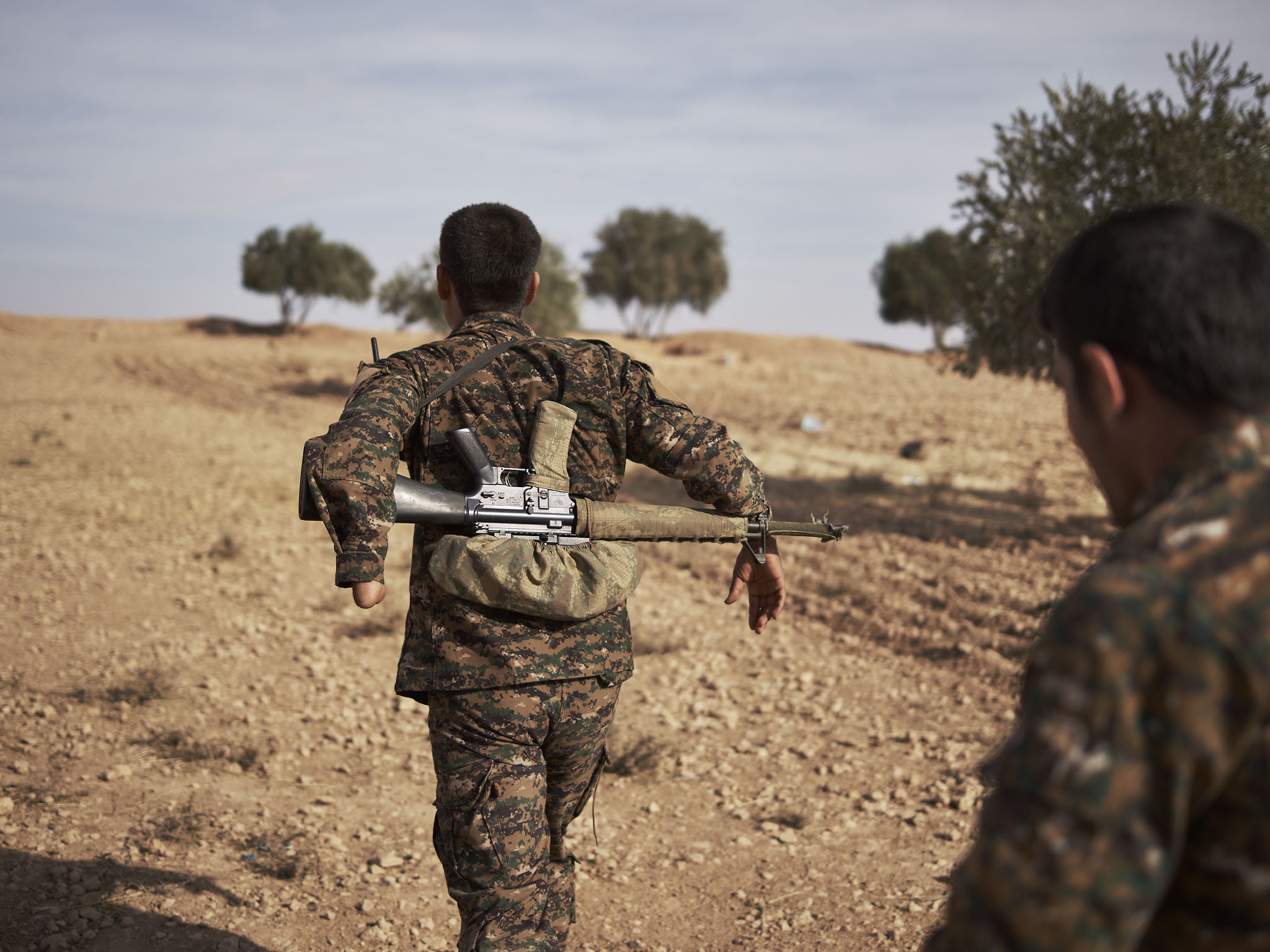
An Injured SDF Fighter walks towards the frontline outside of al-Twelaa, Raqqa Province, Syria.
After a ruthless and exhausting 6 years of war in Syria, only the most ideologically strong militias have managed to flourish, absorbing various fragmented rebel factions and uniting them under strict philosophies. On the frontlines of Raqqa, a battle is raging between the American-backed coalition of Kurdish and Arab fighters known as the Syrian Democratic Forces (SDF) and the Islamic State (ISIS).
The warring creeds could not be any more different. One seeks a decentralized, secular, grassroots version of democracy, while the other seeks a radical interpretation of an Islamic State. Yet, on both sides, soldiers dream of establishing their own version of Utopia, ideologically shaping the world beneath their feet. Bullets in the air take on a dual meaning- seeking to render useless the physical bodies of enemies, but at the same time those bullets hurl towards the others’ ideals. Each side describes the land as “liberated” when the other side fails.
For over 8 months, international journalists and photographers have been blocked from entering the regions of Northern Syria controlled by the SDF due to a strict embargo enforced by all surrounding countries. Despite challenges I am unable to describe here, I was able to gain access and embed with Rojda Felat- the General Commander of the SDF’s “Wrath of the Euphrates” campaign to isolate and surround the city of Raqqa, capital of ISIS’ self-proclaimed caliphate. At the time of writing, the SDF are less than 10 kilometers from the outskirts of the city itself.
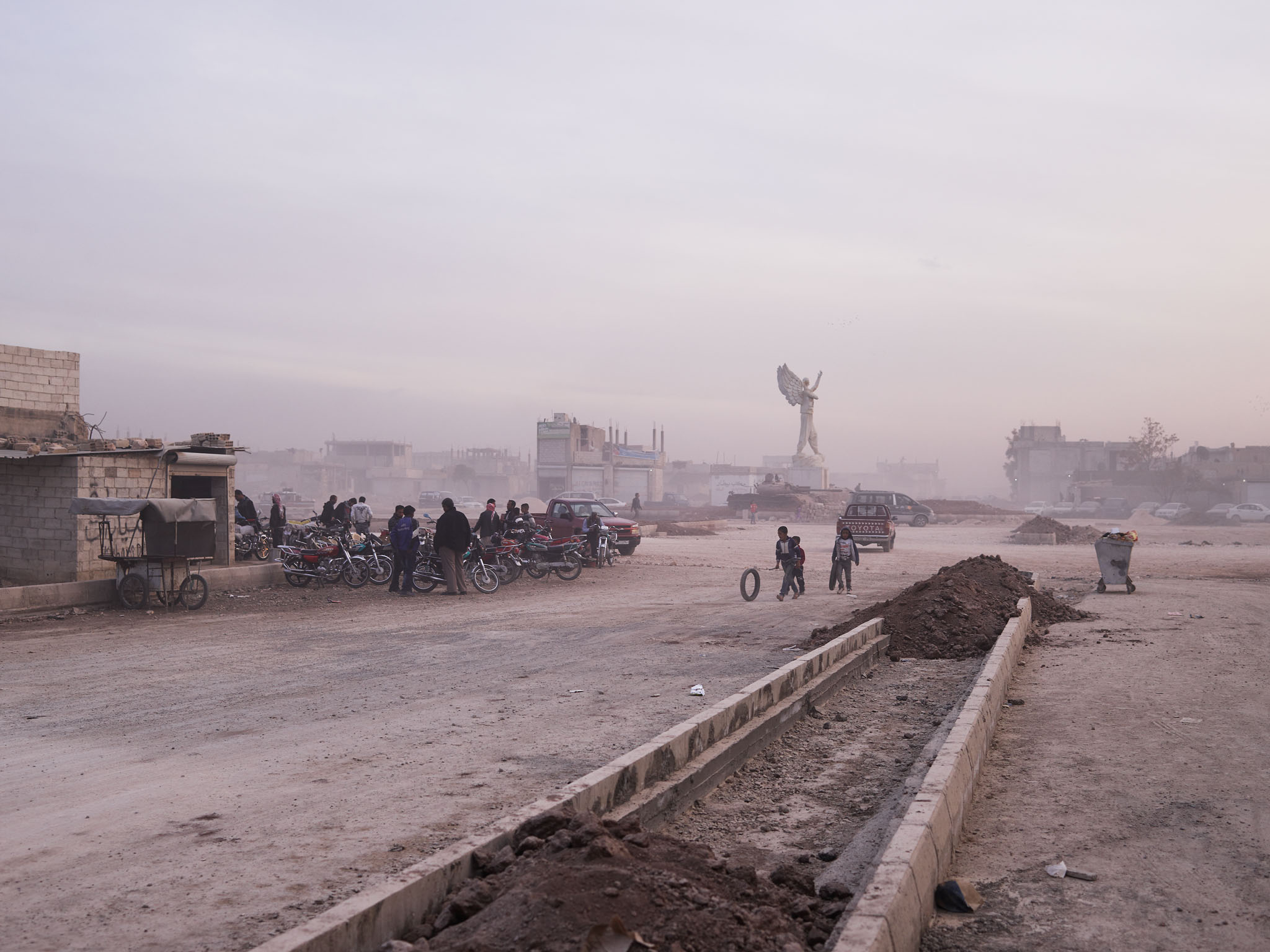
The dusty streets of Kobane with YPJ martyr statue.
Kobane
My journey began in Kobane- a city of anomalies. To understand the new battle for Raqqa, we must first understand the significance of what happened here.
Nestled along the Turkish - Syrian border, Kobane was a quiet, predominately Kurdish city before ISIS propaganda filled our news cycle. In July of 2012, the Syrian Arab Army abandoned Kobane and other Kurdish enclaves of Syria to dedicate their dwindling resources to other areas of the country in conflict with both a rebellion and jihadist insurgency. Kurds were now free of the repressive nature of the Assad regime, but at the same time, they were left on their own to defend themselves from the Al Qaeda linked groups ravaging the country.
Political dissidents in exile returned home to reorganize the fractured society. Weapons were gathered on the black market. Kurdish guerrilla fighters with decades of experience fighting Turkey’s well-equipped military also returned home to Syria from their bases in Iraq’s Qandil Mountains. They became the commanders of a ragtag mix of local volunteers, and shaped the movement under their ideological leader, Abdullah Öcalan. These guerrillas had previously fought for autonomy and minority rights in Kurdish regions of Turkey but were unable to succeed. The power vacuum that emerged in Syrian Kurdistan presented a new opportunity to influence the tide of the war. Thus was born the Kurdish defense units known as the People’s Protections Units (YPG) and the Women’s Protection Units (YPJ)- perhaps the world’s first all-female army. Other spectrums of Kurdish political voices either abandoned the region and fled across the border, or were forced out by the domination of the new power structure.
ISIS, with its ego inflated due to sweeping recent victories across both Syria and Iraq, launched a devastating campaign on the city of Kobane in October 2014. ISIS too had absorbed a patchwork of militias and rebel groups under its black flag, as well as thousands of foreign fighters who took advantage of Turkey’s porous border with Syria to join its ranks. Other predominately Arab rebel groups refused to collaborate with the extremists, and joined the Kurds in defending Kobane- the start of what would make up the core of the future SDF alliance.
With the Turkish border now at their back, the defenders of Kobane were cornered into just a few neighborhoods as ISIS pounded their positions with advanced weaponry and looted tanks. Rather than intervening, the Turkish military sat and watched from its border. The Turkish government knew that if the YPG/J were to be victorious, their own repressed Kurdish population could be inspired to make similar demands for autonomy, or worse, rekindle the same armed struggle that had wrecked havoc for decades. ISIS had become a convenient proxy force for Turkey, capable of destroying the ambitions of their old Kurdish enemies.
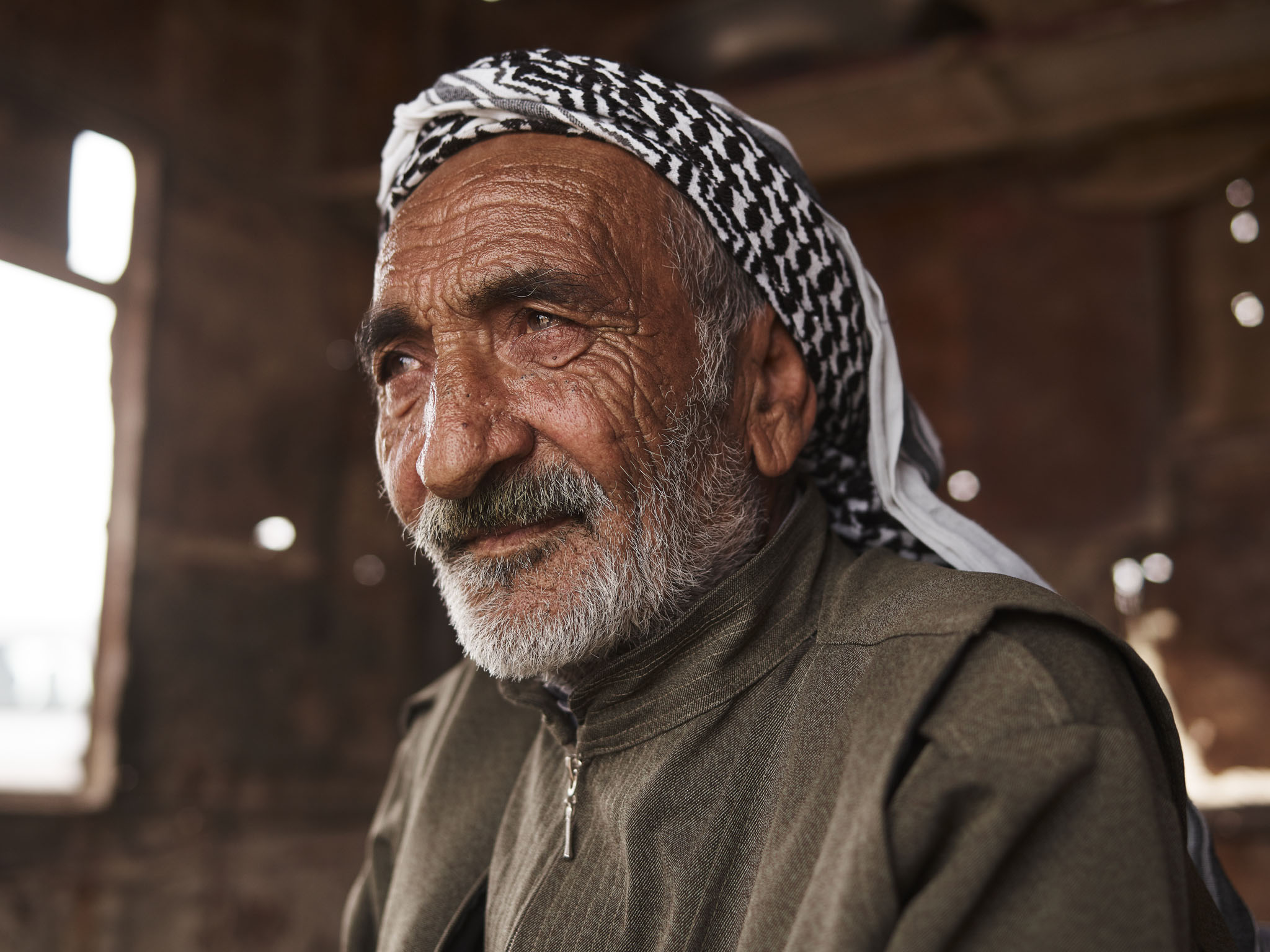
Portrait of Apê Nemir (“Immortal Uncle”), Local hero of Kobane. Ain Issa, Syria.
Not every person seeking to protect Kobane held a weapon. Across the border in Turkey, civilians accused their government of aiding ISIS in the fight, and unleashed unrest in the shape of both protests and violent riots. Volunteers held hands to create a lengthy human-chain to prevent the smuggling of fighters and weapons to the ISIS campaign.
Scenes of the battle filmed by journalists with telephoto lenses from the safety of the Turkish border dominated televisions around the globe and social media. It was an easy media spectacle, presented as a fight between the jihadist force that had recently committed genocide versus an oversimplified version of the YPG and YPJ, with its controversial roots largely ignored.
Much to Turkish President Erdoğan’s dismay, President Obama authorized airstrikes to support this unlikely new ally in Kobane. Anti-interventionists in the West had their beliefs challenged as they watched the brave women of the YPJ suffer heavy losses fighting a brutal enemy that a previous intervention itself had helped manifest. In another paradox, the YPG and YPJ, with its Öcalan-inspired anti-capitalist theory, benefitted significantly from American airpower paid for by the US tax dollar.
Against all odds, the YPG, YPJ and their rebel allies eventually declared victory over the city. They had proved to the world for the first time that ISIS wasn’t the unstoppable boogeyman its propaganda had suggested. However, the achievement came at great cost of human life and infrastructure.
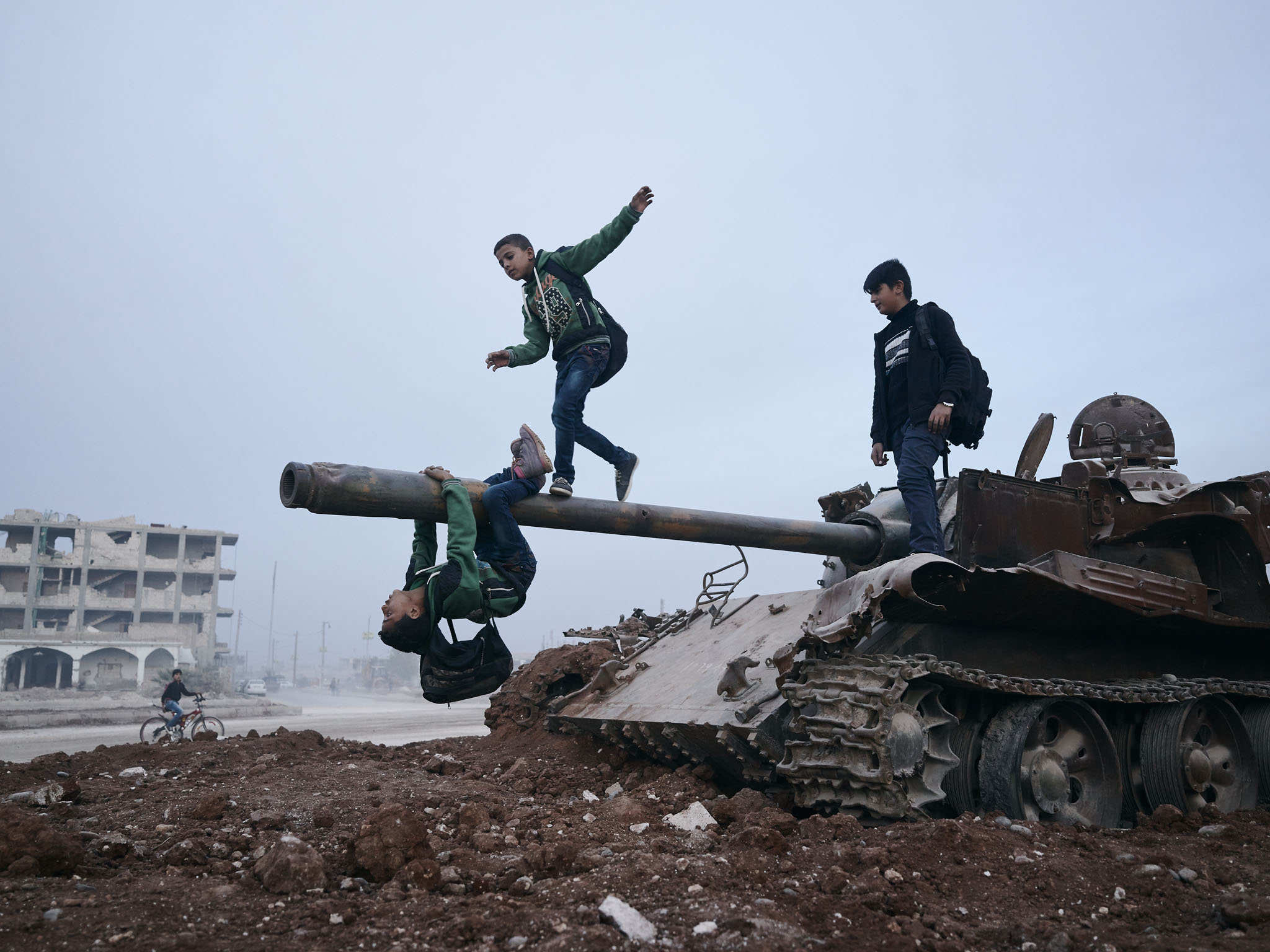
Amude and Memo, children of Kobane school learning in the Kurdish language for the first time.
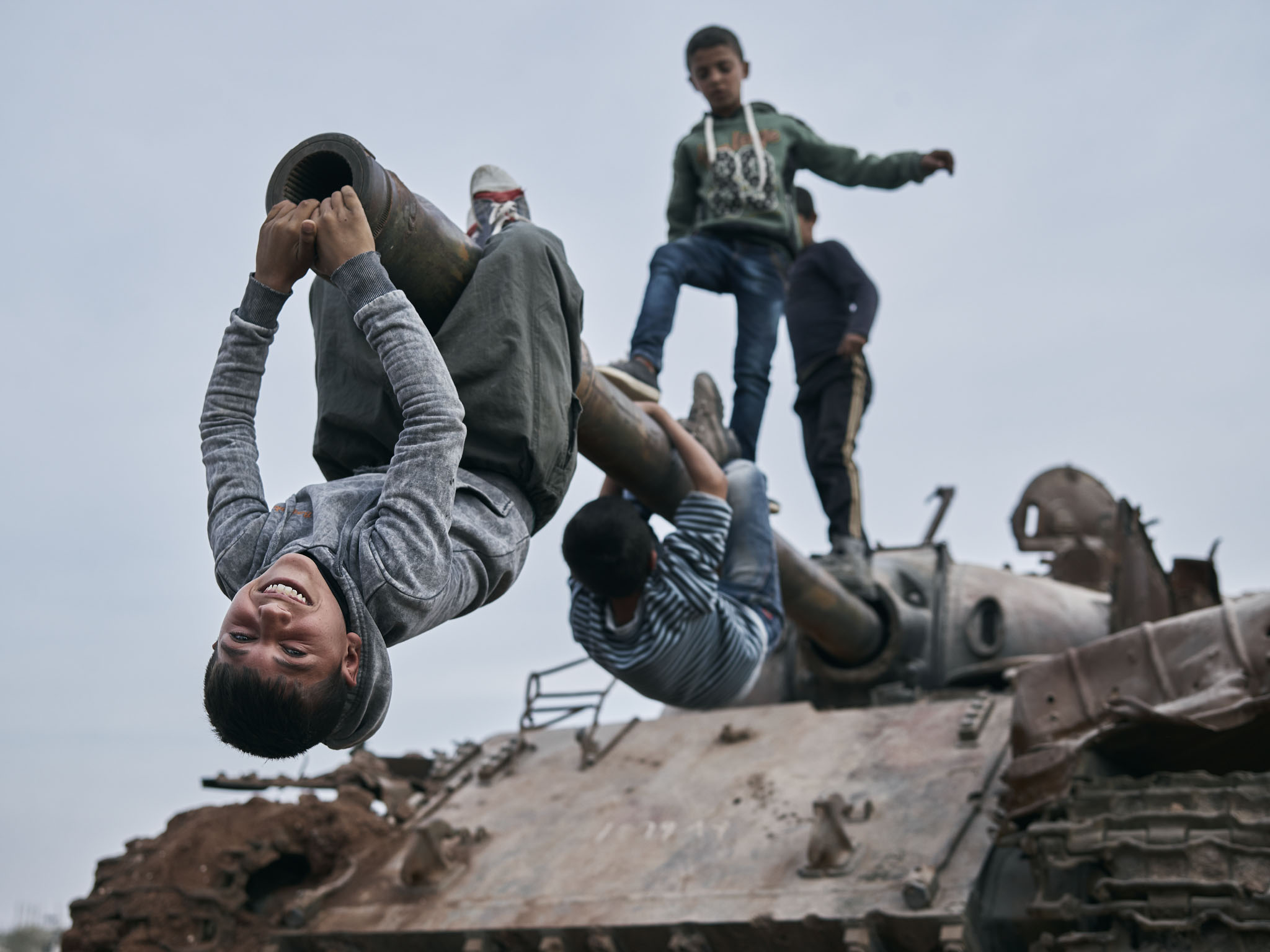
Salar and friends play on a destroyed ISIS tank.
Walking through the streets of Kobane with a camera in hand reveals a city back to life and thriving under the experimental self-administration system, but also a level of destruction that will take years, if not decades to repair. Peering into holes in the sides of eviscerated buildings reveal what used to be Kurdish homes- plastic ceiling fans are melted from the heat and fires of air strikes or rocket propelled grenades. A water truck roams the corridors of abandoned neighborhoods, wetting main roads to keep the concrete dust from spreading through the air. By nightfall, the roads are dry again, and the dust creates a low-lying layer of fog.
The same tanks the world saw ISIS make their advances in are now derelict monuments in a public roundabout. Kids on their way home from school play and dangle upside from the tank’s gun. With the Syrian regime’s Baathist education programs expelled by the new administration, they are learning their once outlawed Kurdish language in school for the first time.
The television cameras set up from the Turkish side of the border may have stopped broadcasting updates from Kobane, but those same fighters haven’t stopped moving. They have continued onward, growing in both size and sophistication. The SDF is now one of the most diverse and successful coalitions in Syria. Convoys of both Kurdish and Arab fighters are advancing in Raqqa’s expansive countryside, with other brigades snaking along the winding path of the Euphrates River, using the water as a natural barrier, all the way to the gates of the city.
Despite controversies over its founding members, the SDF has also grown into America’s most trusted friend in Syria. The coalition air support the Obama administration began continues under Trump, as well as the insertion of hundreds of French and American Special Operations Forces (SOF) in advisory positions.
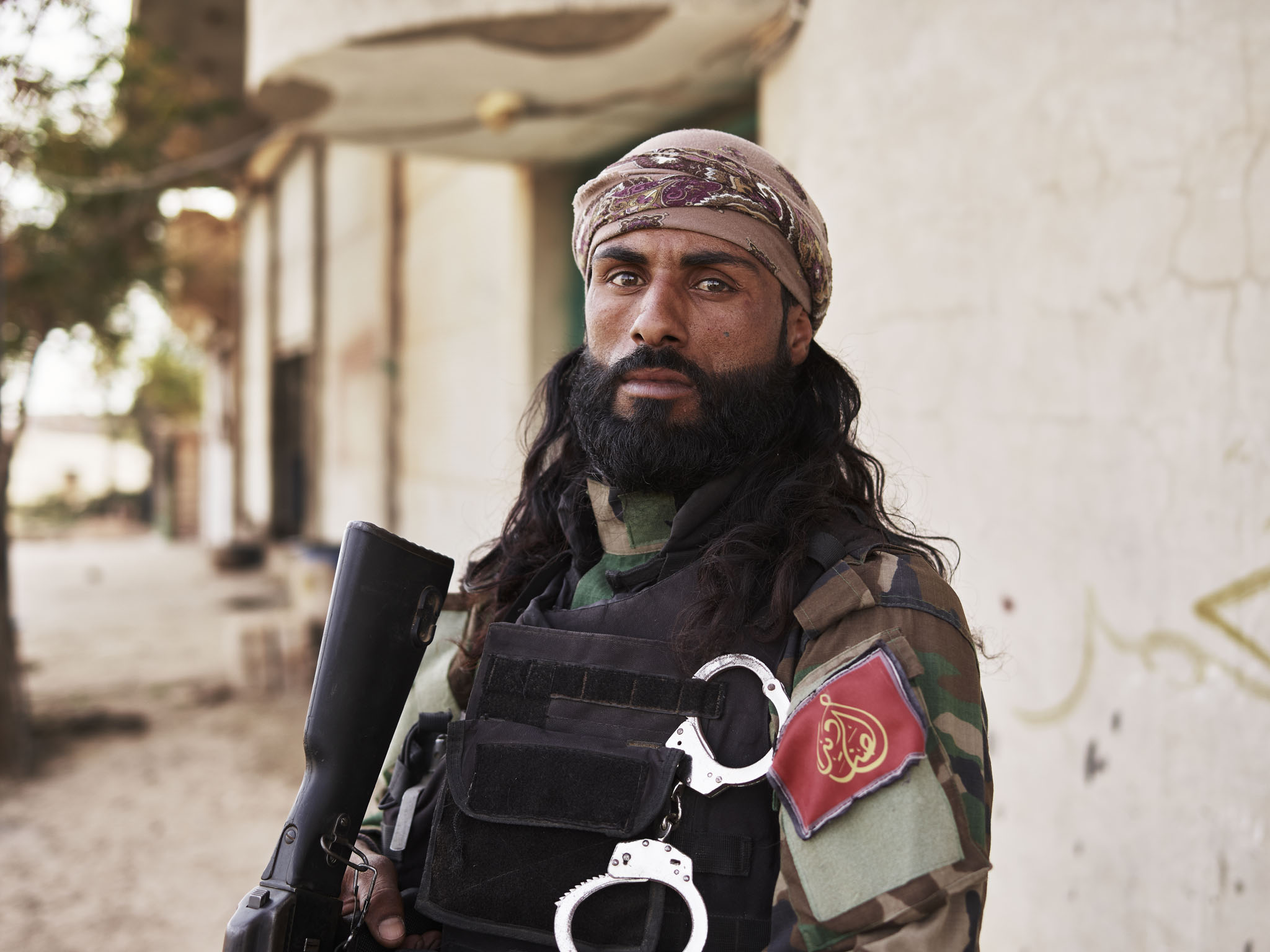
Faisel, a member of Al-Sanadid Forces, SDF. Al Hishah, Raqqa Province, Syria.
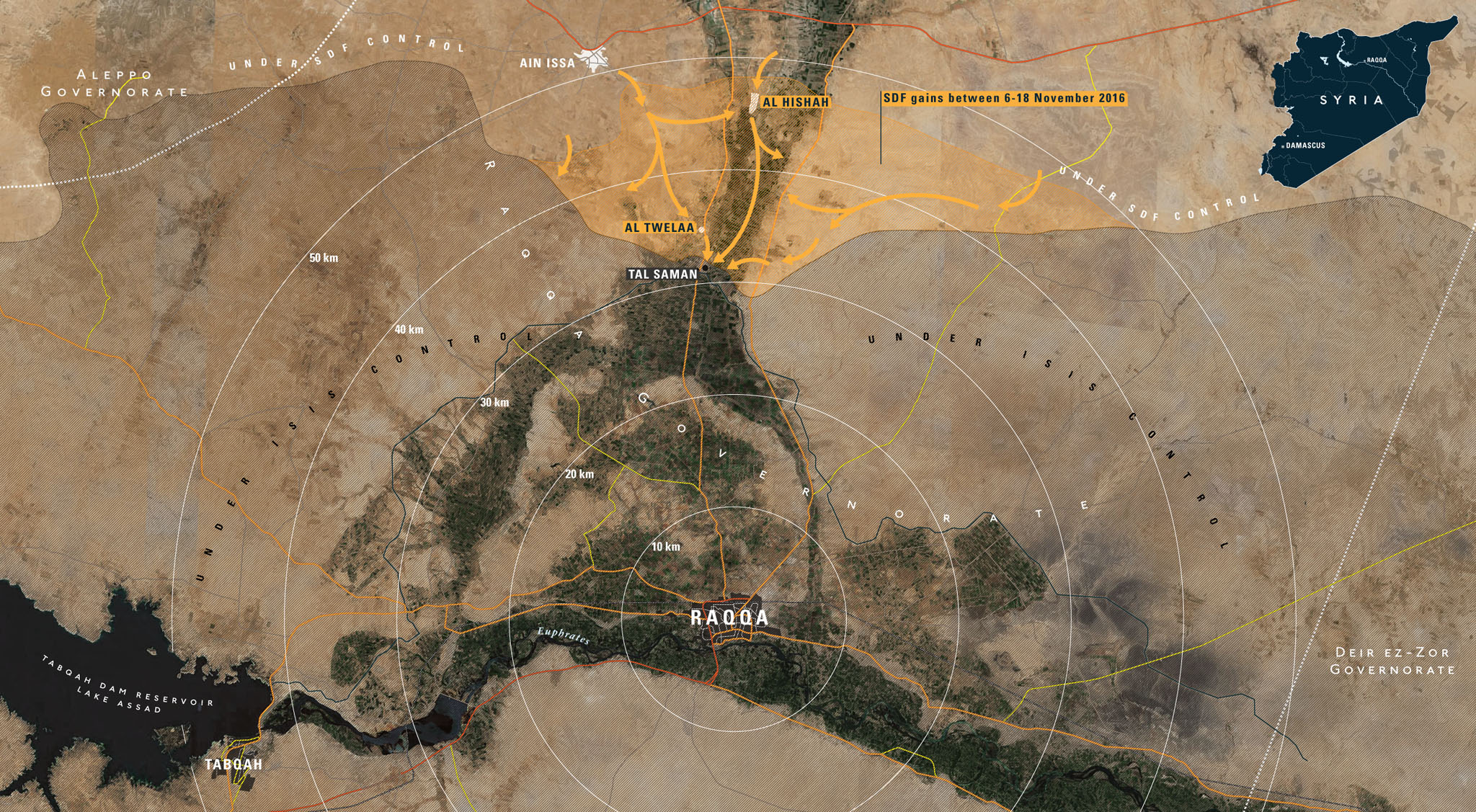
Map provided by @LCarabinier
Al Hishah
I set off from Kobane with my friend and translator, local journalist Jan Êzîdxelo. Our pickup truck moved alongside a YPG convoy heading to Ain Issa, a large city north of Raqqa. From there, we navigated south to al Hishah- a village in which ISIS was ousted just days before our arrival.
We drove through many of the dusty small hamlets and villages that make up the frontline, which is constantly shifting and expanding rapidly due to the desolate nature of the landscape. After areas are taken from ISIS, bulldozers move in quickly, making temporary berm walls to consolidate minor defenses, then continue pushing onwards. The campaign may be moving fast now, but will likely see its bloodiest days if the SDF manages to reach the city of Raqqa itself.
We reach a building just outside al Hishah, and I am instructed that Commander Rojda Felat is on the roof. Jan and I slowly walk up an outdoor concrete staircase, and first see Rojda standing with her back to us- a stout figure looking out over the horizon with a tactical radio in hand. She is short in stature, and this is only exaggerated by a long thick braid of dark hair which falls past her lower back. Her voice is strict and authoritative, and several female fighters beside her scribble notes as she dictates. Suddenly, Rojda notices us, smiles and waves, but then returns to her radio. It’s buzzing with reports from the commanders of the various groups in the coalition. As she dials through each radio channel, her eyes are fixed in the distance, as if visualizing the movements being described to her in the open plains ahead.
Twenty minutes later, there is a pause in the radio chatter, and things seem to calm. Rojda walks over to me, and through Jan's translation, she apologizes for making me wait. I explain that no apology is necessary- (uhh, I know you are busy fighting ISIS.)
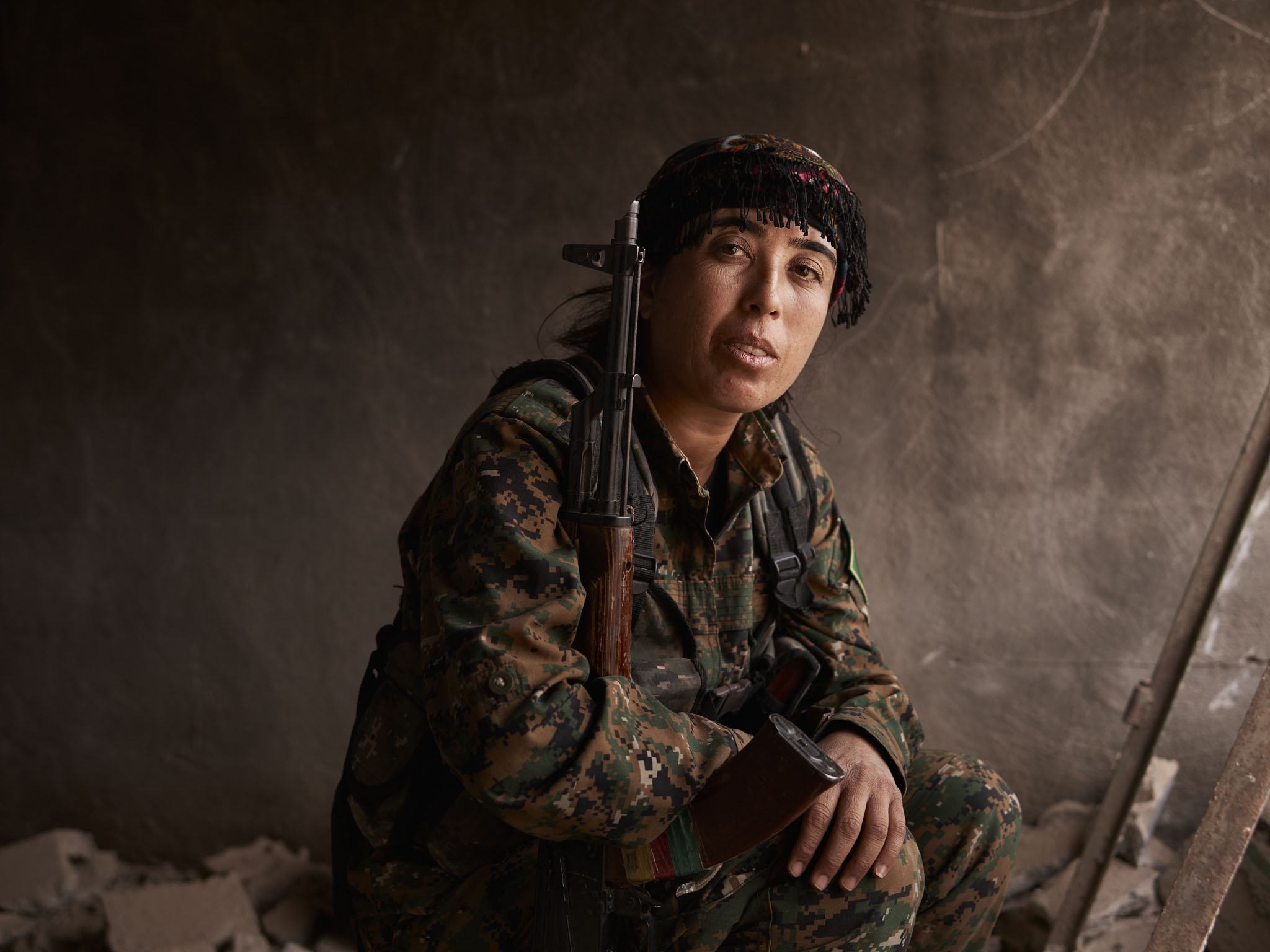
Portrait of Rojda Felat, SDF General Commander of "Wrath of the Euphrates" Operation. Al-Twelaa, Raqqa Province, Syria.
As I explain that I wish to embed with her and take photographs, Rojda’s large round eyes study me closely, as if trying to read my intentions. The authoritative tone heard over the radio is gone, and she is warm and friendly, often with a big toothy smile spreading across her face. When speaking, she barely breaks eye contact, and uses a calming hypnotic voice I have found to be common among former guerrillas who spent time training in the Qandil Mountains. It is uncertain if she has, but her new role is clear- she is a key lynchpin in the SDF.
Rojda agrees to let me tag along and photograph her, but explains that she is very busy now, and will pick me up the following morning. Together, we will travel to each new position, and observe the ongoing battle. It’s getting late, so she suggests my driver take me to a YPG position so I can bunk with a nearby male unit.
As we drive back through the empty streets of al-Hishah, we suddenly meet its missing population. A long line of motorcycles and cars wait on the main road heading into town. It’s the local Arab villagers, and they seem eager to return to their homes. Personal belongings are piled high on top of their vehicles, as if unsure how long they were going to be displaced from the fighting. They had to wait several days for the battle to be over, and until the SDF troops allowed the civilians to enter.
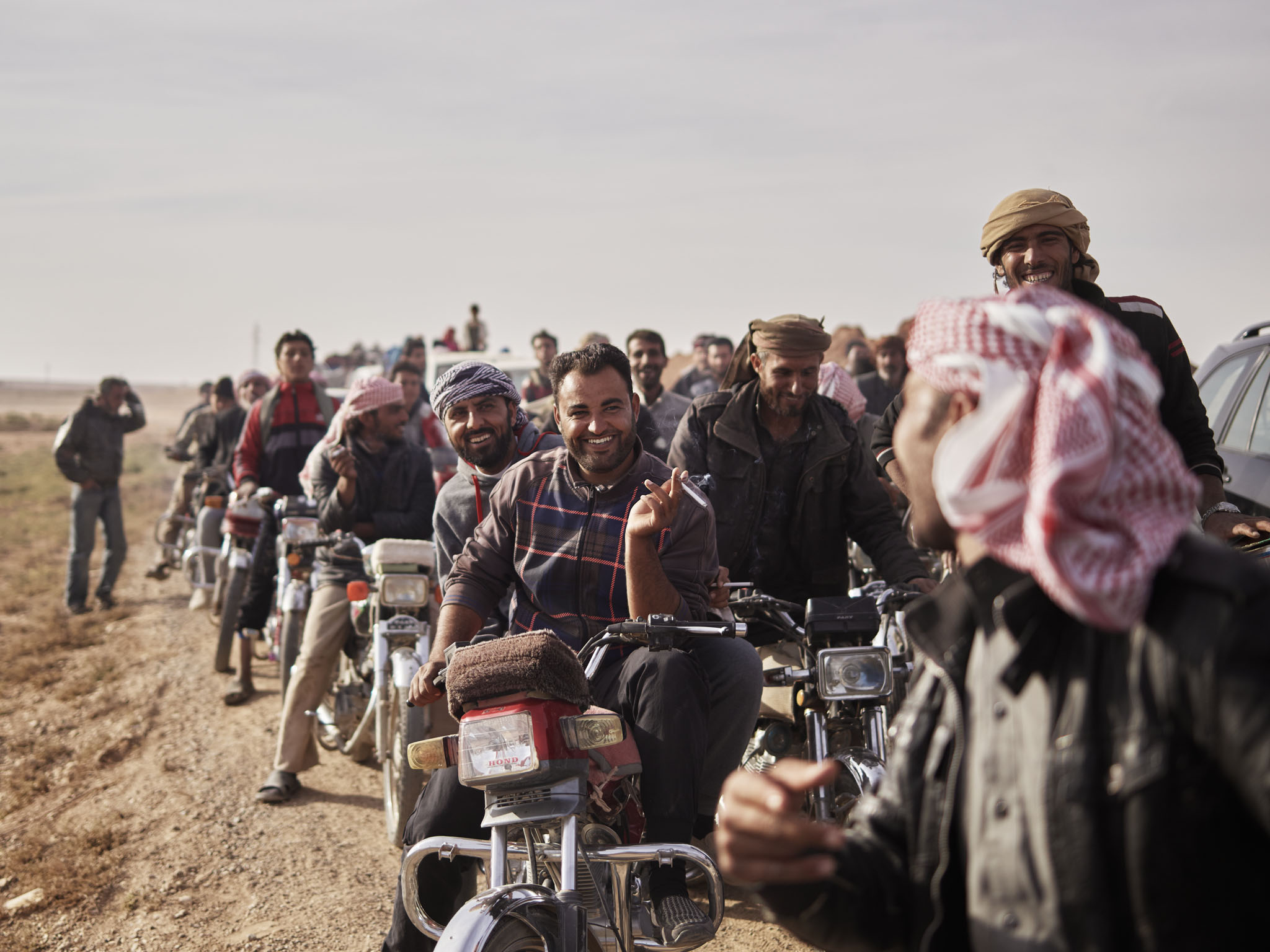
Locals of Al Hishah que to return home.
With their engines idling, I approached a group of men on motorcycles to photograph and ask some questions. I mentioned that the spokesperson and main commanders for the offensive are both female. Knowing how male-dominated and traditional the society is in this region of Syria, especially after having been so recently under the control ISIS, I was curious on how they felt about the prominent role played by the women. “We don't care if it’s a man or woman who is liberating us, we just want to go home,” exclaimed the man, wagging his finger in the air as he spoke.
It was an easy answer when your fate of returning home depends on an armed group. There was a lot more to ask but suddenly our conversation was interrupted by a huge explosion coming from the direction of the village. People waiting in the queue climbed a wall of dirt beside the road to get a better look. A huge plume of smoke rose in the air above the village.
We would learn later that it was a last unused ISIS suicide car equipped with explosives, sitting booby-trapped inside a civilian garage. The SDF team had de-mined it, blowing it up in place to render it harmless. Suddenly, the road was opened and the civilians were allowed to move. They honked their horns, waved to my camera, and smiled broadly as they returned to their homes.
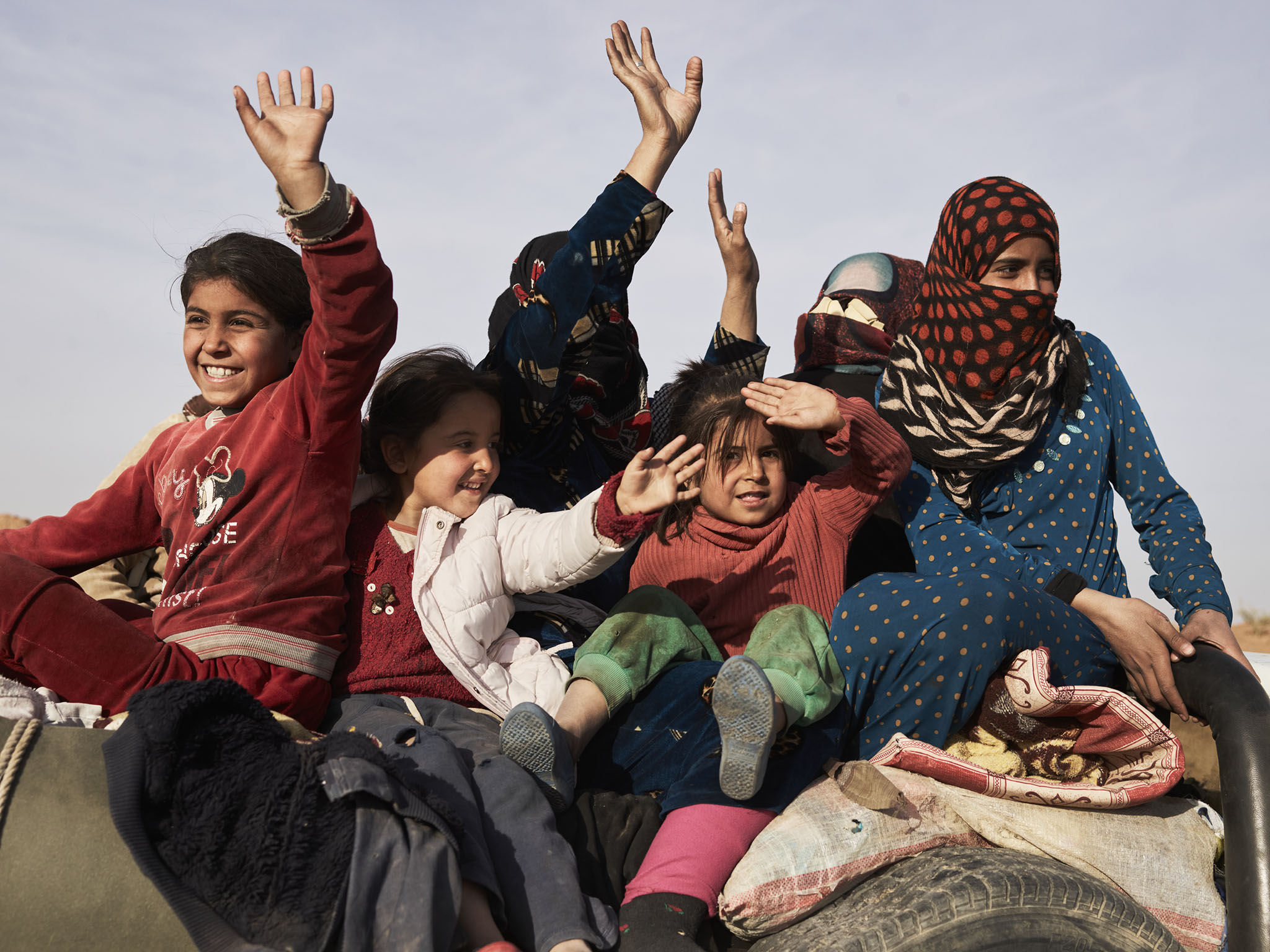
Locals of Al Hishah celebrate as they drive home after their city was liberated from ISIS by SDF .
It seemed so perfect that it could almost be a planned propaganda exercise-"Look, the predominately Kurdish force is helping the Arabs! Send us more weapons, America!” Except, there were no foreign journalists expected to be there, and an orchestration of this size seems nearly impossible.
Camp on the Frontline
Just a short drive away from the newly liberated village, we reached the YPG base Rojda had given us permission to sleep at. About 20 fighters in mismatched camouflage fatigues shared an abandoned farm equipment storage facility made out of grey cinder blocks. A vast empty horizon loomed in the distance- there were no main roads, just sand, but counter attacks could come from anywhere.
Upon climbing out of our truck, we are greeted by a wave of handshakes from charismatic young men led by Murat Amed- the commander of the camp. They are surprised to see me, but happy to let me stay and photograph anything now that I have Rojda’s blessing.
As dusk descended, our driver decided to return to Kobane, admitting that he didn’t trust the nearby Arab population who had just been under the authority of ISIS, fearing sleeper cells. “I’ve got kids,” he murmured dryly, starring at the ground, and eventually drove off.
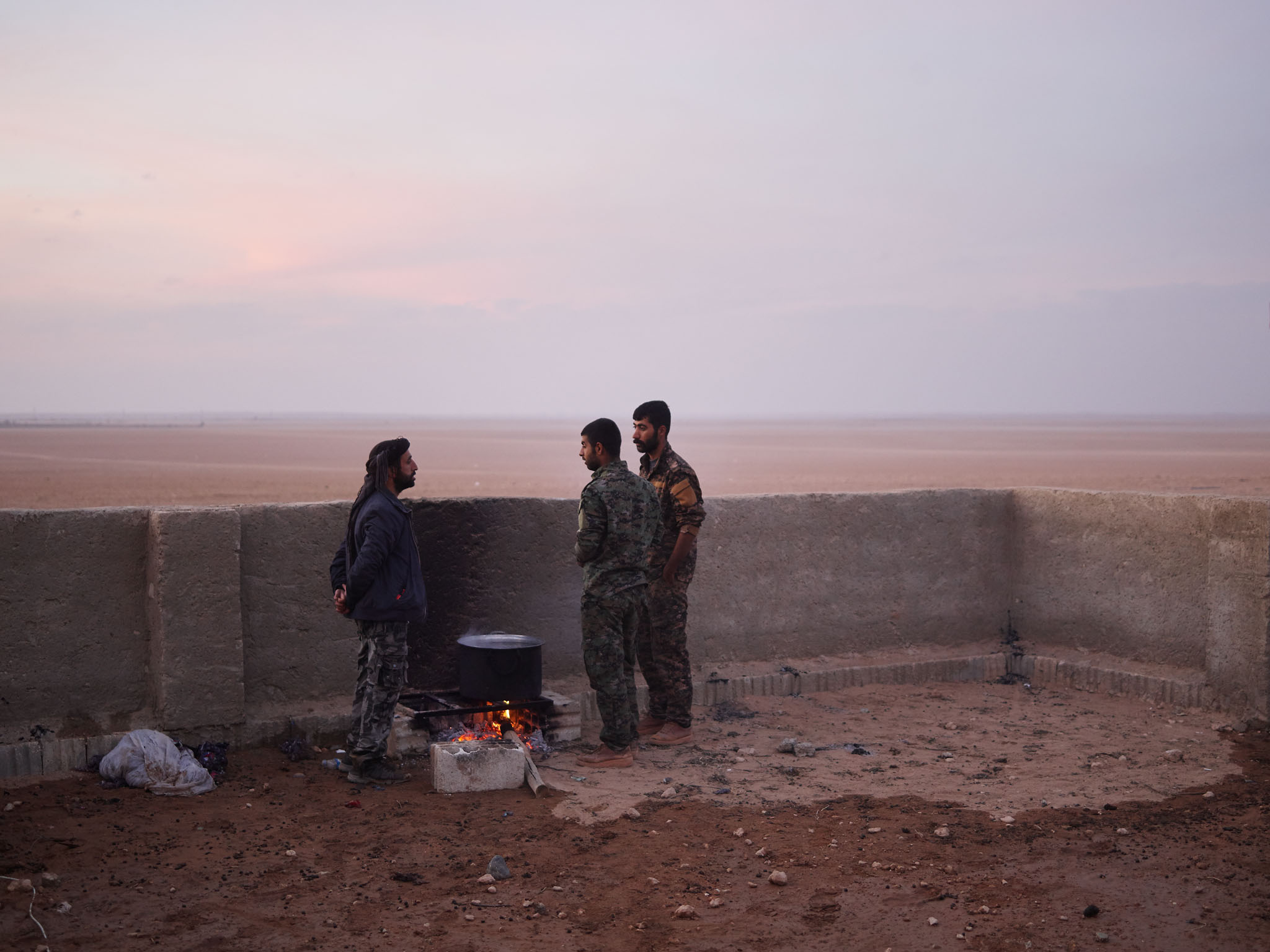
SDF camp near the frontline of Raqqa.
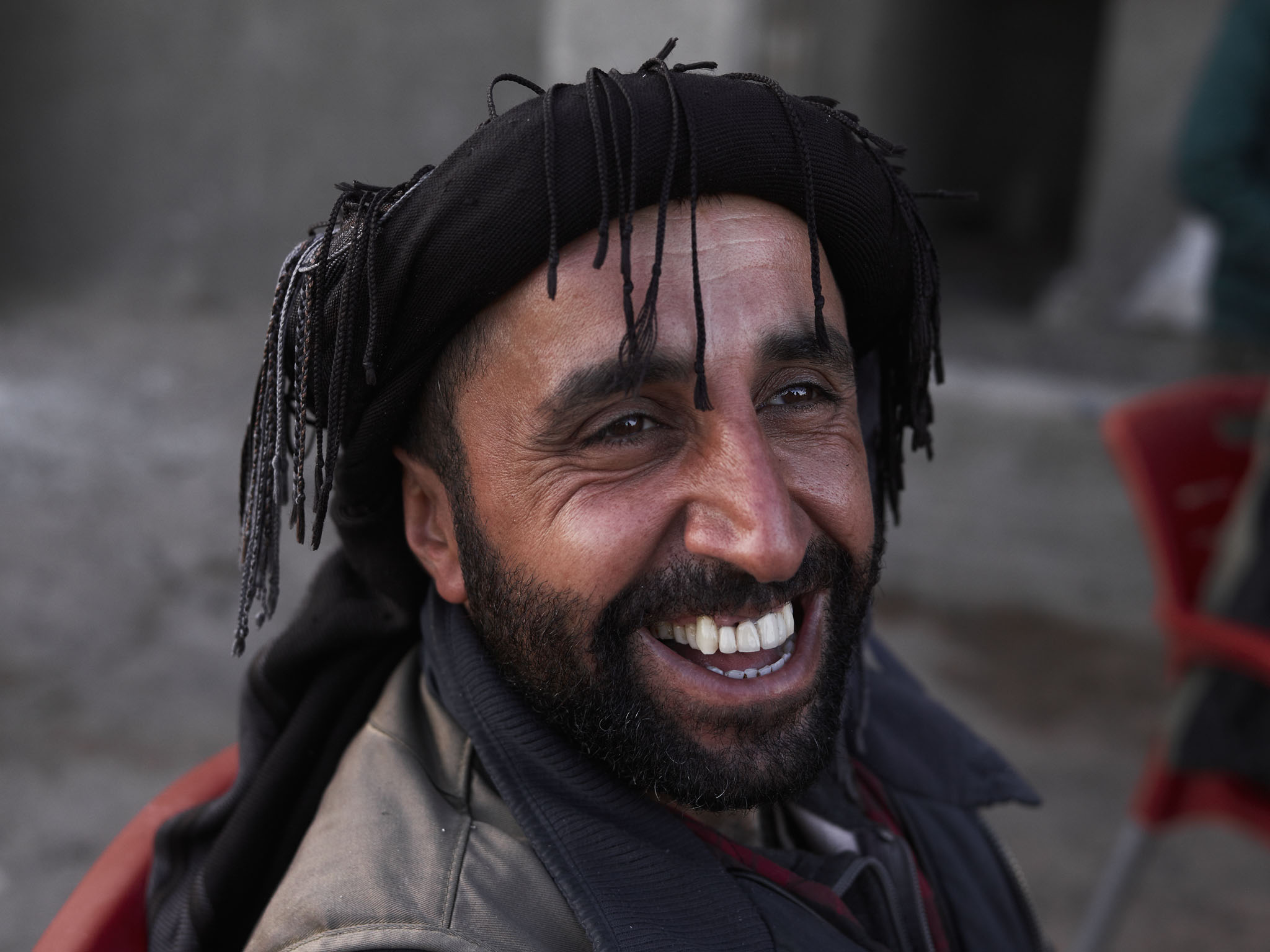
Portrait of Murat Amed.
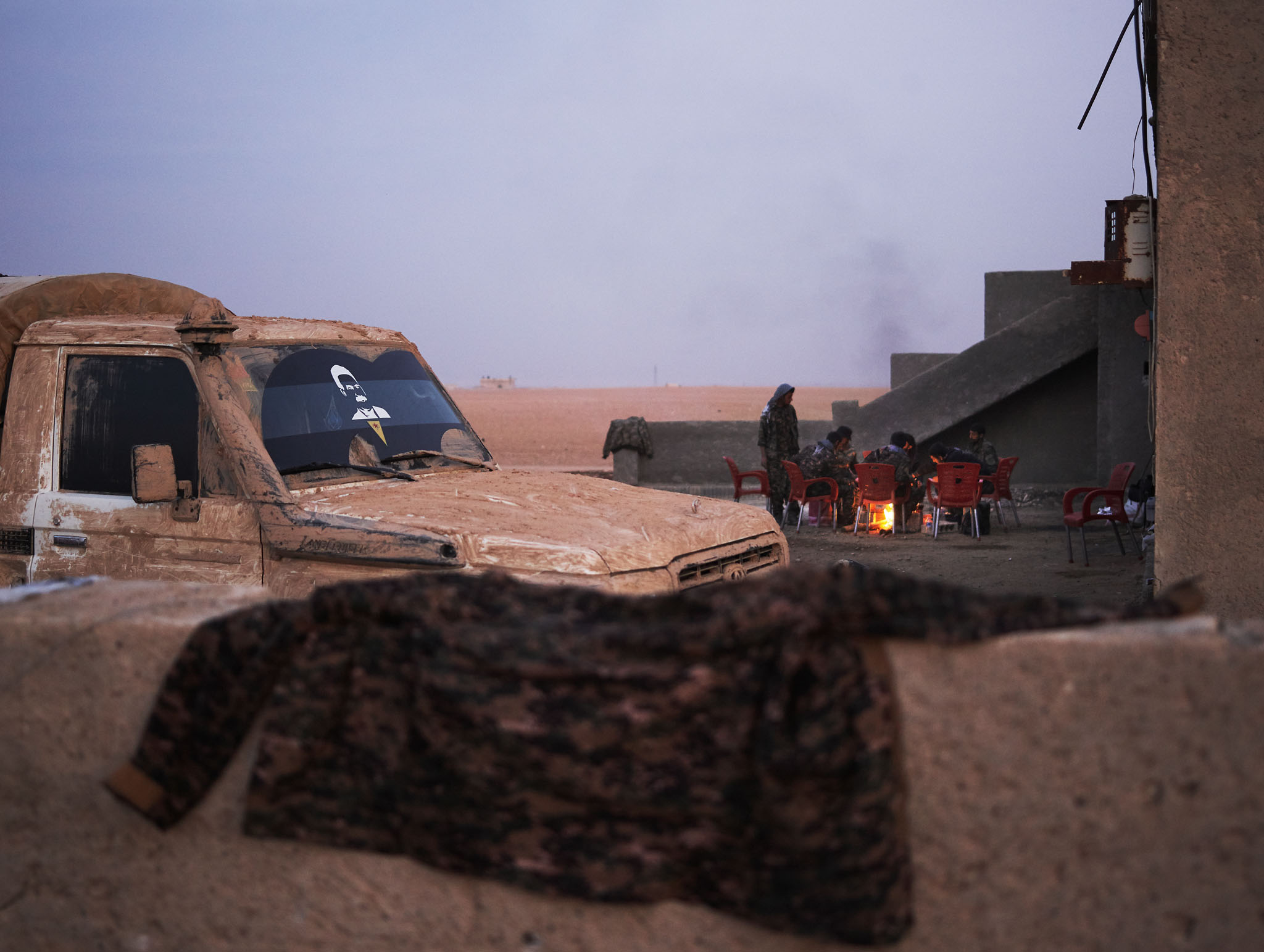
An Abdullah Öcalan decal on a YPG military vehicle.
Jan and I sat with the SDF fighters on plastic chairs surrounding a small campfire. Murat was now cooking hamburgers in an iron griddle. After tea was poured, we dove into talks about politics. I ask them what they think of Donald Trump’s recent win as President of the United States.
“The American people can decide for their own country, it’s not for us to say,” carefully explained the first fighter to answer.
“Come on, be honest,” I say. “That’s the same excuse politicians use to dodge the question.”
Another chimes in, “It would have been nice for a woman to win, but Clinton is the one who let all the jihadists in here. She is a puppet of Erdoğan and the Gulf.”
Another disagrees, “It doesn’t really matter. The outcome will always be the same no matter who is President. It is a system.”
As self-trained and independent these fighters have been over the years, they know the next American President’s decisions will ultimately be a powerful voice in the international proxy war the Syrian conflict has evolved into. With hostile actors as neighbors, leading the operation for Raqqa itself is a future political bargaining chip for the SDF.
“Like all politicians, we will judge by their actions,” Murat explained, taking on a serious tone. The rest nod in agreement, suddenly careful with their words.
There are sleeping mats set up on the roof of the building where a group of fighters are rotating every few hours keeping watch, but they insist I sleep inside where it’s warmer. In a room filled with weapons and ammunition, Murat arranges some blankets for me while holding his flashlight in his mouth, and politely refuses to let me help. He may be the commander, but these kinds of duties are shared by all. It seems the hospitality Kurds are well known for can even be found on the front line.
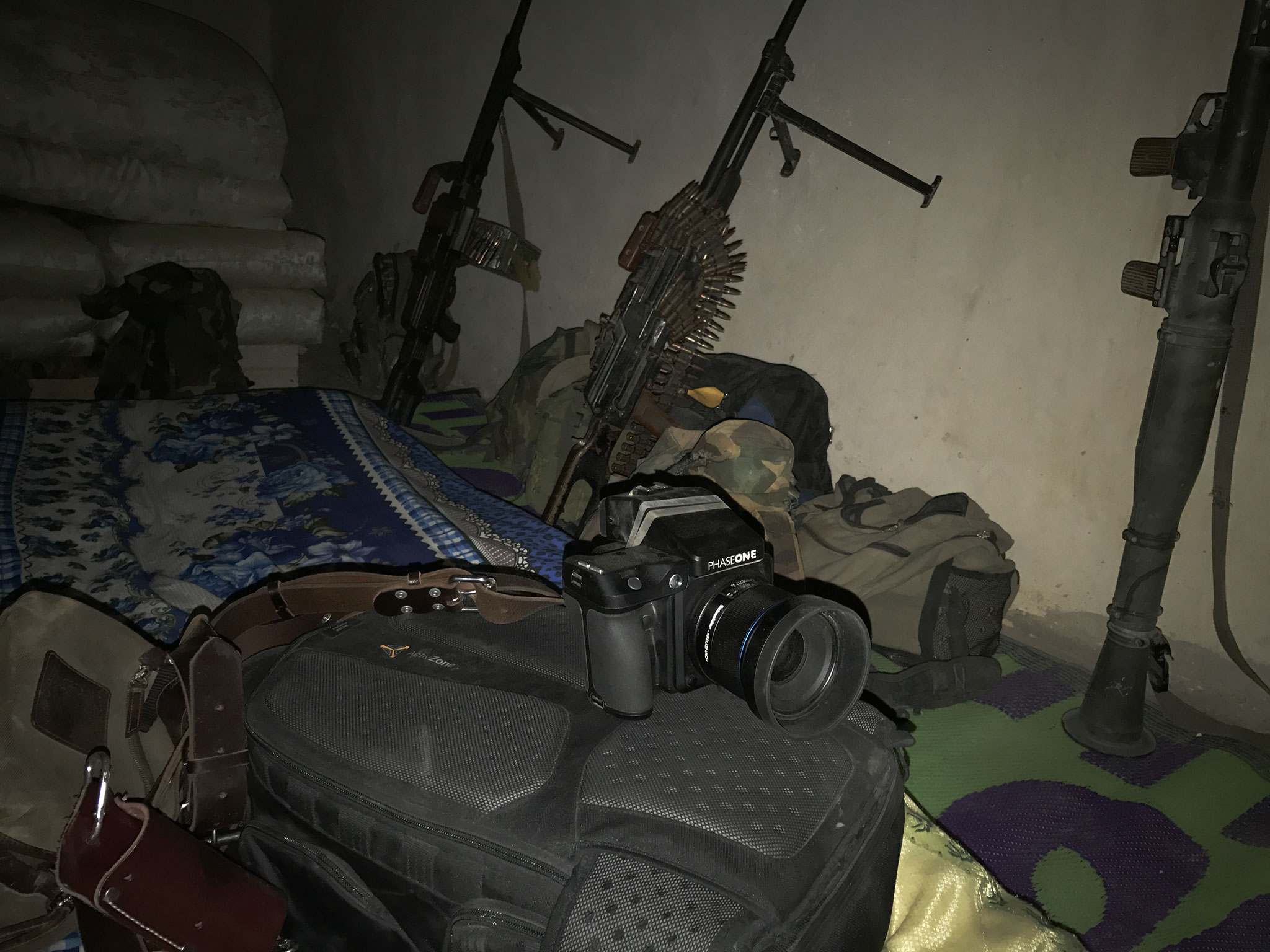
My camera among some other weapons in our sleeping quarters...
Before falling asleep, I show Murat some of the photos I took of them on the screen of my camera. “You send my sister,” he says in broken English. Murat pulls out a number scribbled in his journal and repeats “whatsapp, whatsapp, whatsapp.” No translation is needed.
Al Twelaa
I am awoken by Murat tapping on my shoulder at 5am. The fighters are still gathered around the fire, as if the scene from the previous night never ended. While I slept, they had been taking turns watching the camp. An hour later, a pickup truck pulls up. It’s Rojda and two of her rooftop partners from yesterday. She joins us and we all have breakfast together as the sun rises. The YPG seem happy to see the General Commander make an appearance at their base, and their morale appears to be immediately uplifted.
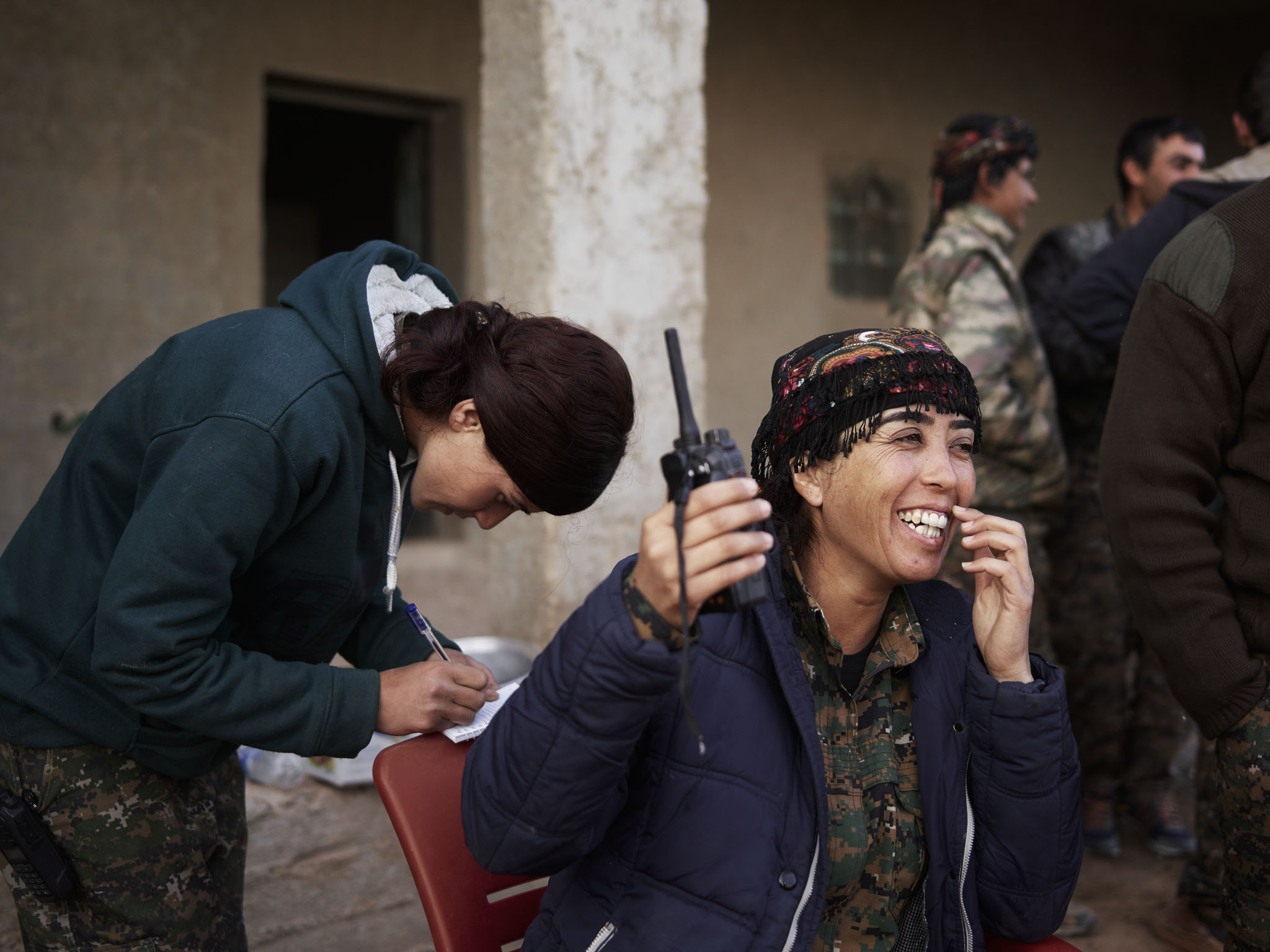
Rojda Felat co ordinates the locations of SDF frontline groups.
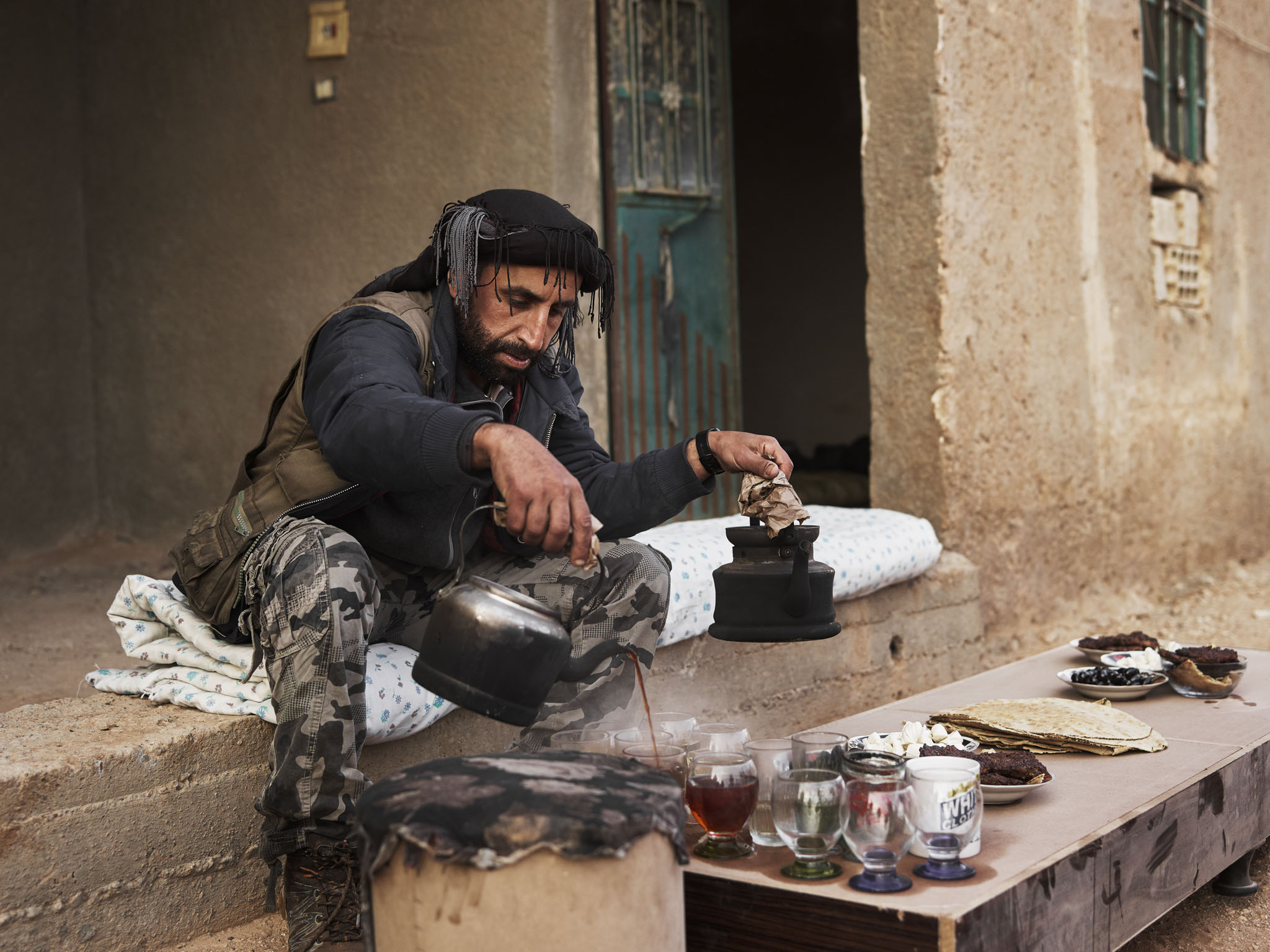
Murat Amed prepares breakfast.
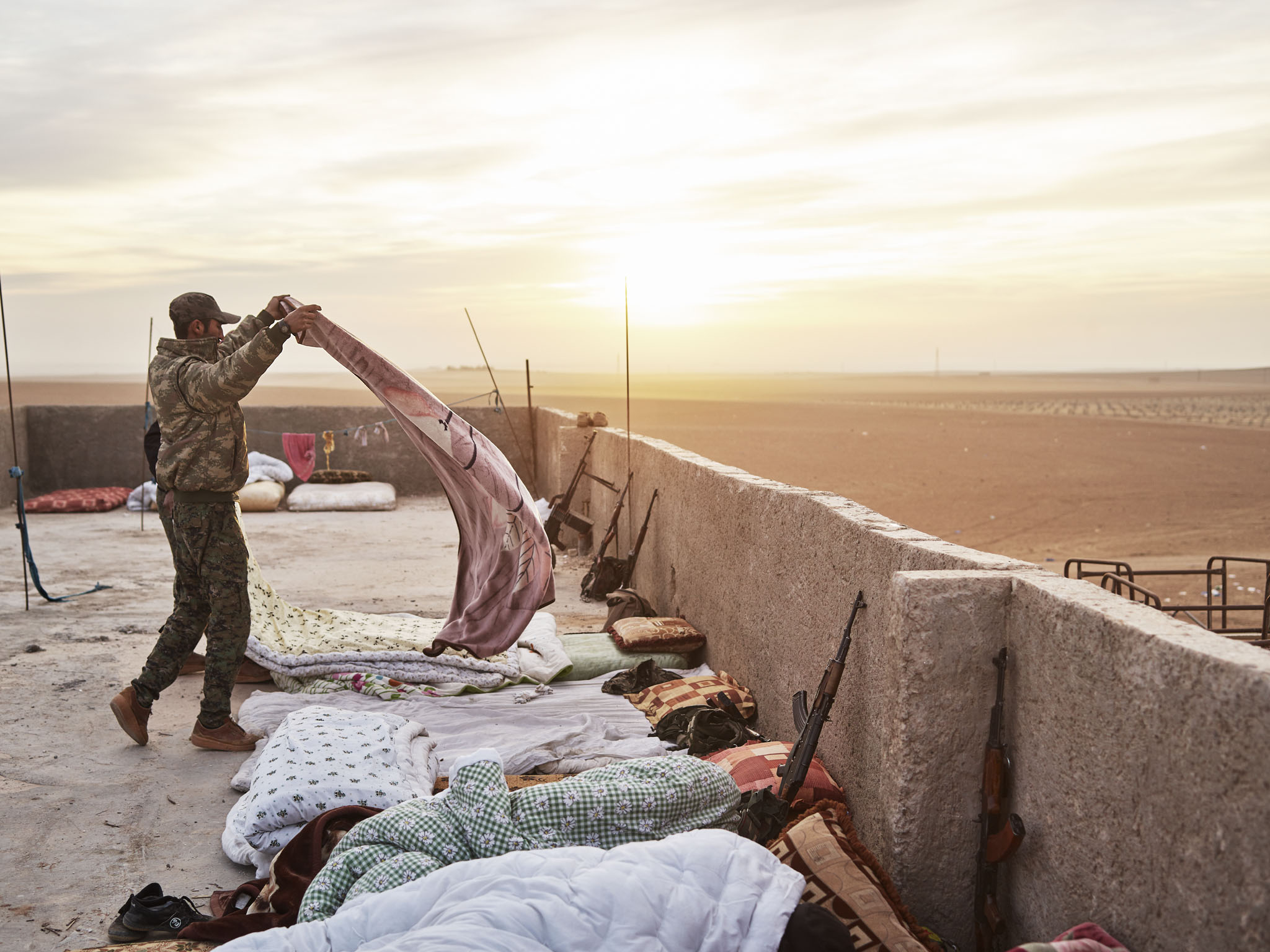
Rooftop camp on the frontline of Raqqa.
Jan and I pile into Rojda’s pickup truck with the two other YPJ fighters, and together we take off down a dirt road towards the town of al Twelaa. But first, the pickup truck makes a quick pit stop at a lonely building on the town’s outskirts.
“There are American Special Forces here,” Rojda explains. “It’s okay for you to see each other, but we please ask that you don’t take any photos of them.”
On the building’s rooftop was what could only be described as the classic Hollywood stereotype of Special Forces: six men with grizzly beards, sunglasses, muscular tattooed arms bulging out of tan t-shirts and bags full of military equipment.
For a moment, I felt confused at the protocol and don’t want to ruin the trust Rojda has put in me, so I decide to hang back and not interrupt their work. However, by nature I am a nosy person, and this idea quickly dissolves. It was fascinating to watch them engage with Rojda via their interpreter. Despite how sophisticated or trained the Americans are, they seemed to rely on Rojda’s forces to coordinate their entry to the frontline, where they plan to contribute to the next phase of the offensive. This small group of Special Forces have something in common with SDF units: all are decentralized by doctrine, and are able to make swift decisions in combat. The SOF primarily aid the SDF by calling in airstrikes and using heavy weapons, such as the javelin- an advanced rocket system useful for taking out approaching suicide cars. The US coalition is hesitant to provide the SDF directly with these kinds of heavy weapons due to pressure from Turkey, who fears them falling into the hands of the same Kurdish guerrillas they are at war with. The short-term goal is to take Tal Saman- a nearby city surrounded by more expansive countryside, and the last obstacle to connect the frontline to the other separate group working their way down the Euphrates River.
The Americans head off the rooftop towards their vehicle, nod at me with a simple “Hey dude,” and say no more, driving off on their separate way. I suppose that we are both not supposed to see each other. We follow Rojda into Al-Twelaa alongside some other SDF fighters from the base.
As we travel through the newly captured village walking in a single file to avoid buried mines, curiosities of the war begin to reveal themselves. Hidden inside a barn, there is a 1 meter by 1 meter dirt tunnel ISIS used to pop up from a neighboring village. Outside the barn, there are the remains of a large piece of artillery destroyed by a coalition airstrike.

SDF fighters survey the site of a coalition airstrike that destroyed an ISIS artillery position.
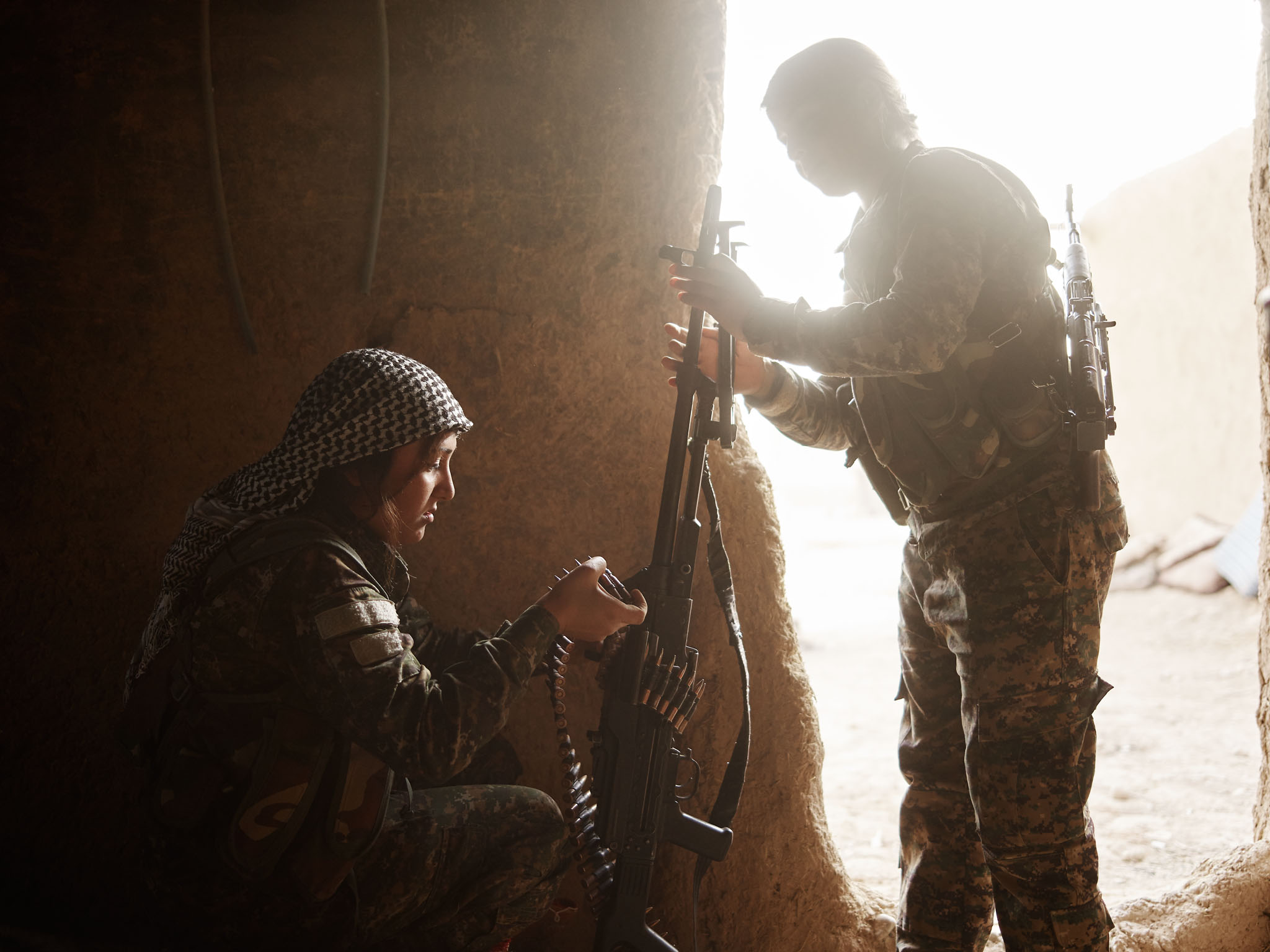
Zilan and Arin, members of YPJ, prep a PKM machine gun in an ammunition storage shed.
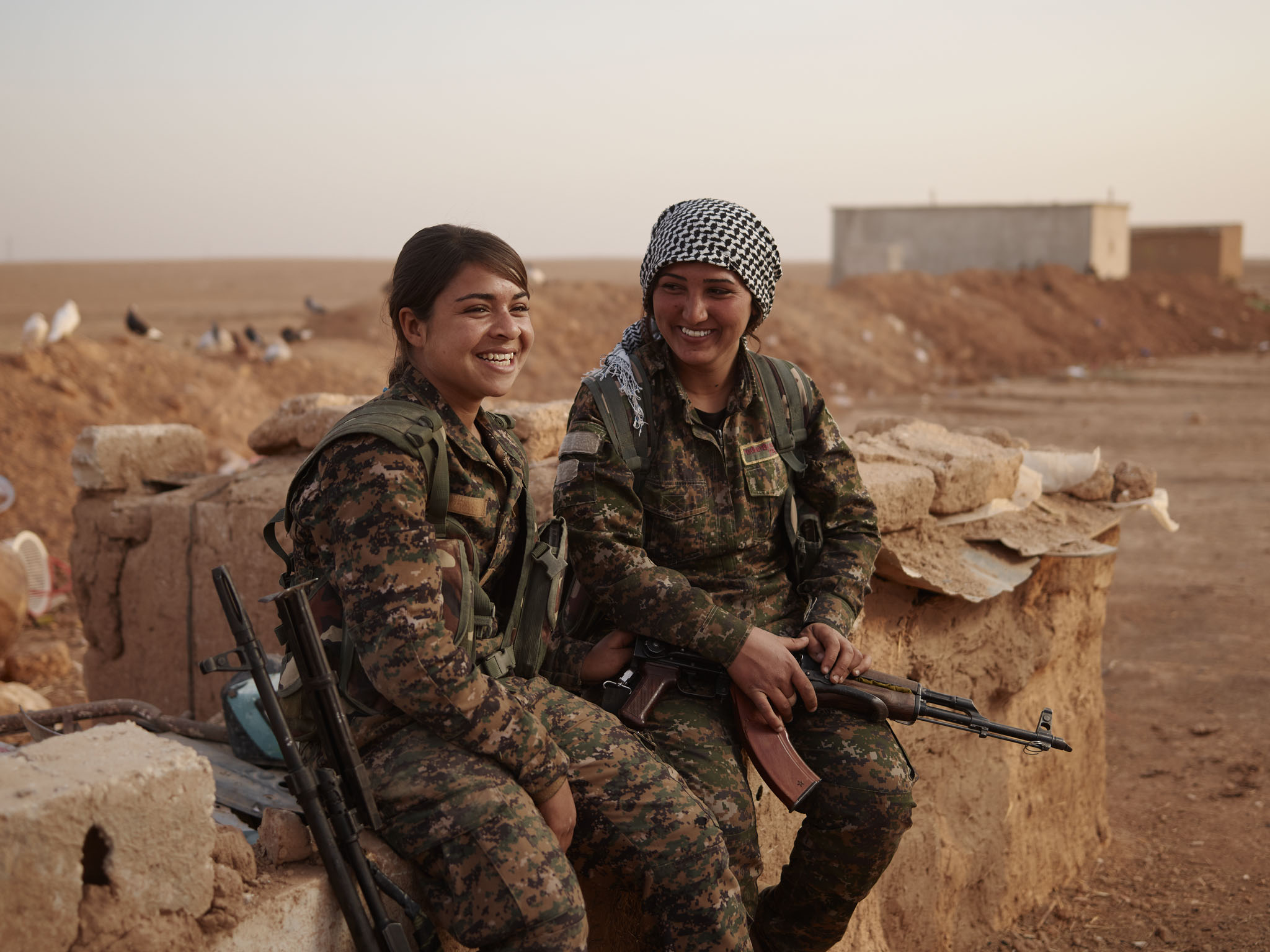
Portrait of Arin and Zilan.

Rojda Felat.
Rojda leads us along a path to a position where a SDF unit is monitoring the flanks on the sidelines of Tal Saman while the main operation goes on. A small group of 15 fighters are gathered, gazing through binoculars and sniper rifle scopes. Their role is to report and strike any enemy movement or suicide cars that ISIS may send from this side against the larger operation currently unfolding. The small village in front of us is quiet, but the thuds of mortars, machine guns and the occasional coalition airstrike can be heard in booming in the distance.
“Nothing is happening here, sorry it’s a bit boring,” laughs Rojda.
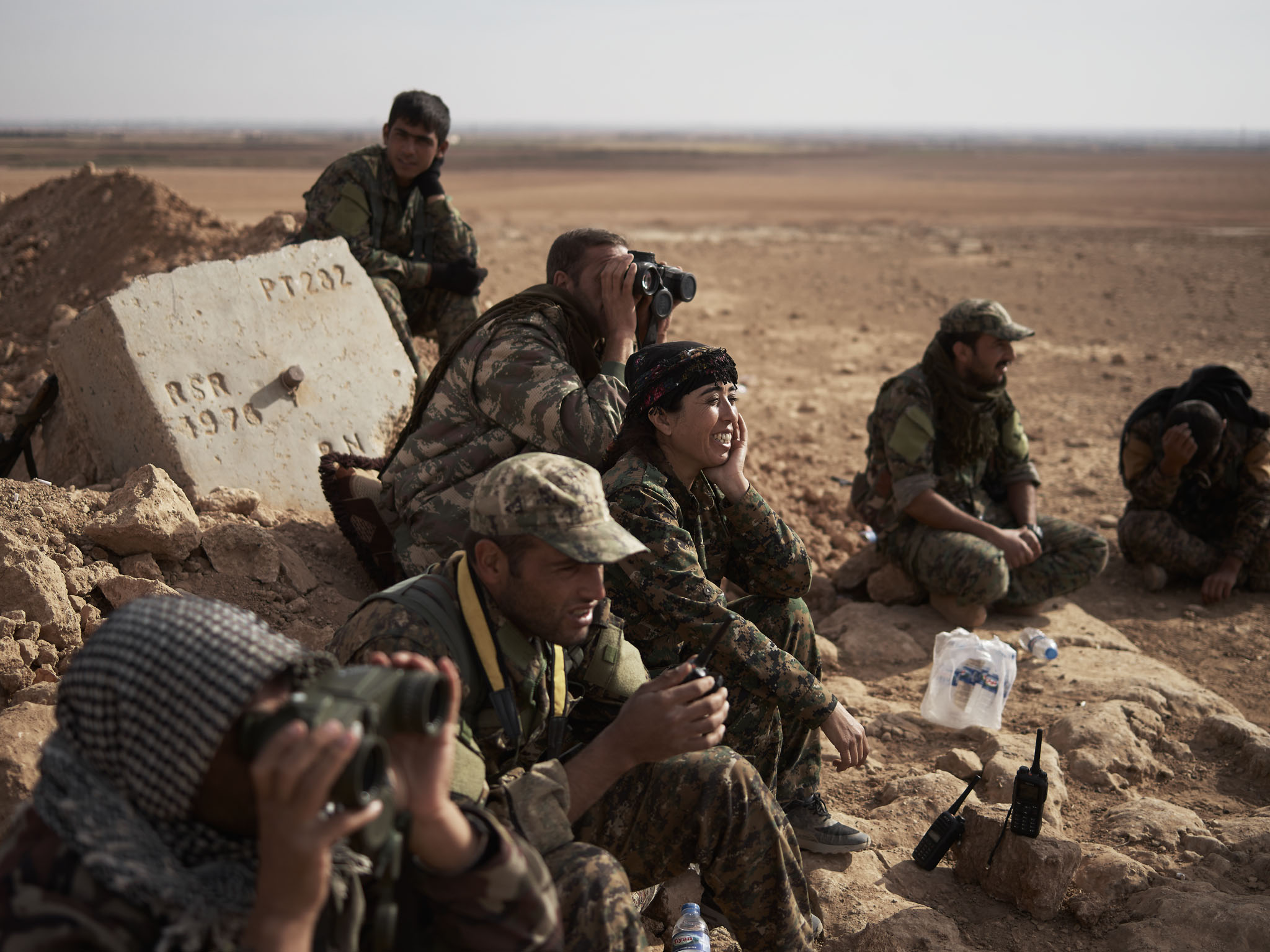
Rojda Felat surveys a flank of Tal al-Samam with other SDF commanders.
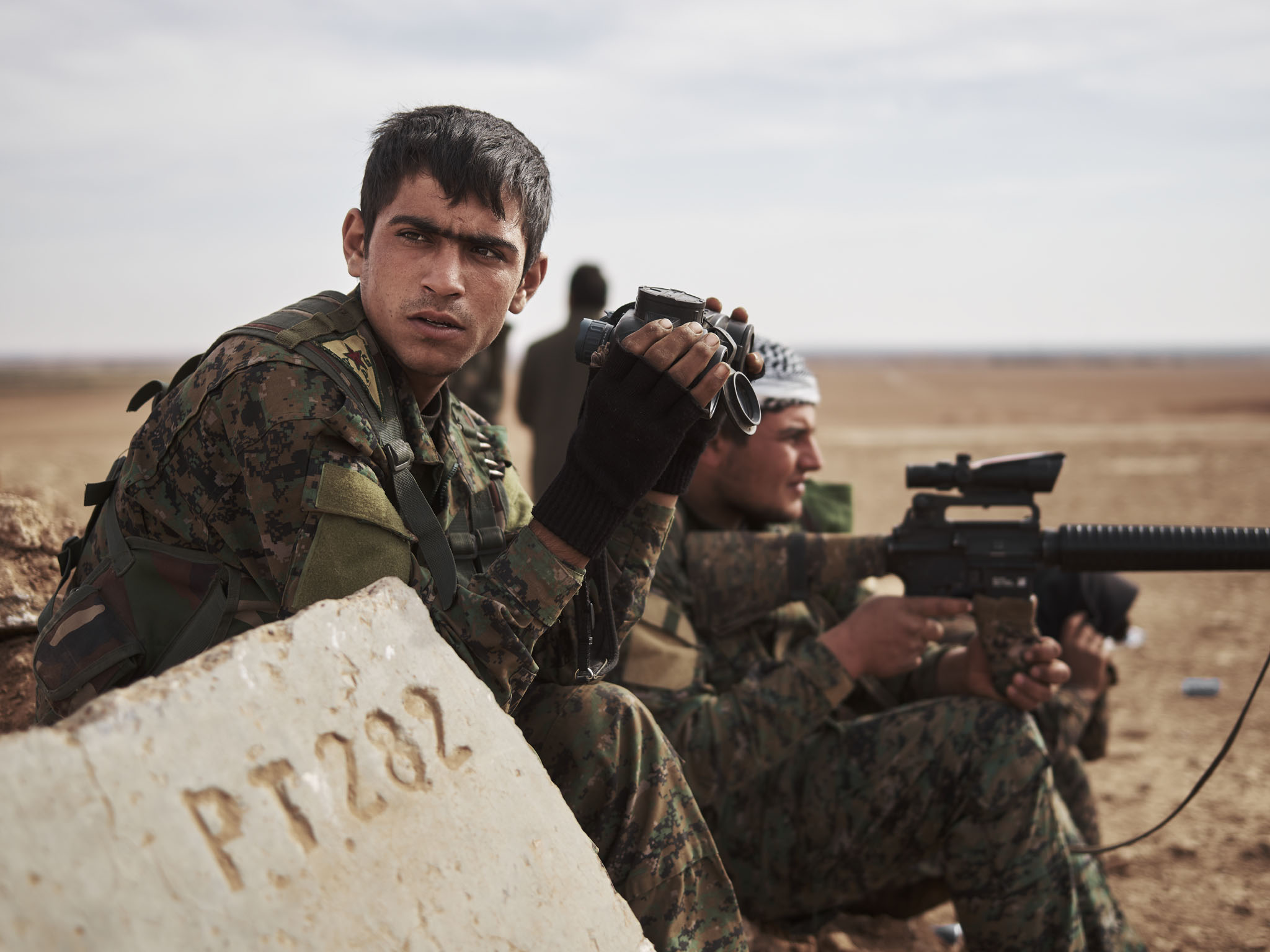
Using binoculars and scopes, SDF fighters watch for ISIS infiltration or suicide vehicles.
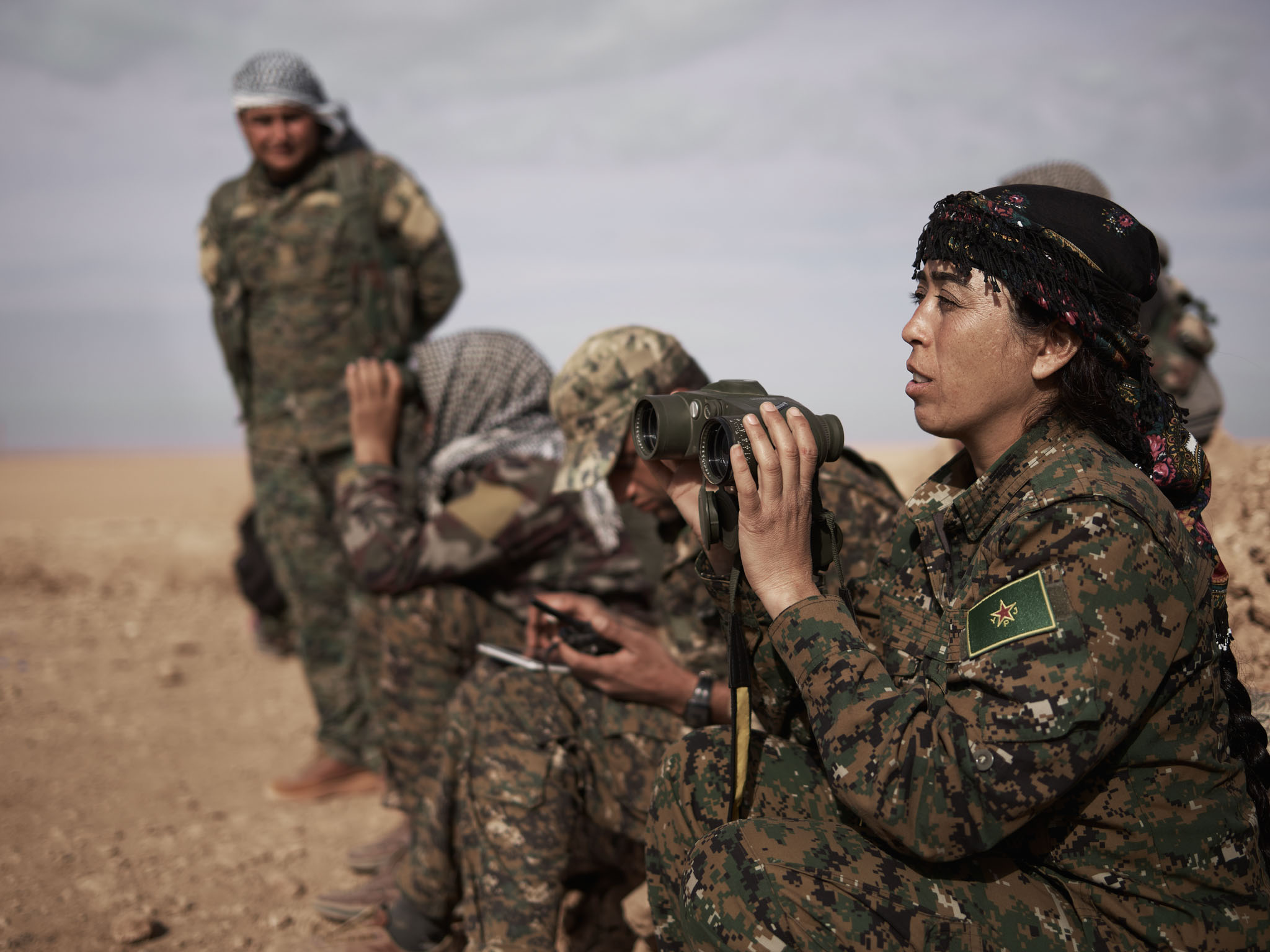
Rojda Felat.
Before calling it a day, I photograph Rojda inside a half-destroyed shed. The walls are ash gray from a fire, and rubble is spread across the ground. It is unclear if the room is booby-trapped, but the light is perfect for a portrait. Jan turns to me, “I hope we all don’t get blown up over a photo.”
The Battle of Tal al Saman
The next day, we would go to the heart of the fighting, in Tal al Saman. Rojda admitted she had other duties to attend to, but instead sent me with the SDF's upstart media department. They happen to be a team of 4 fighters no different from the others, except for holding a camera in the hand their rifle is not in. They have handy-cams and a GoPro with no extra battery.
“If we manage to enter today, if we are lucky, we can see them pull the big ISIS flag down in the city center,” the media team explained, “maybe that would be a good shot?”
Together, we travelled to a large power station on the outskirts of Tal al Saman. A small dam contains an artificial reservoir of water, and a network of smaller concrete water channels nearby provided a safe staging area. From here, only about 1 kilometer of open land separates us from the nearest ISIS-firing position, and a little further onwards lays the city of Tal al Saman itself. We are told a small group of SDF fighters are at the edge of the city, and currently under fierce resistance from ISIS.
We cross the dam’s bridge on foot toward three fighters manning a heavy machine gun mounted in the back of a pickup truck nestled in between a wall of dirt and a concrete reservoir. Suddenly, their radio calls from the fighters up at the frontline and they fire several large rounds in succession at the ISIS position described over the airwaves.
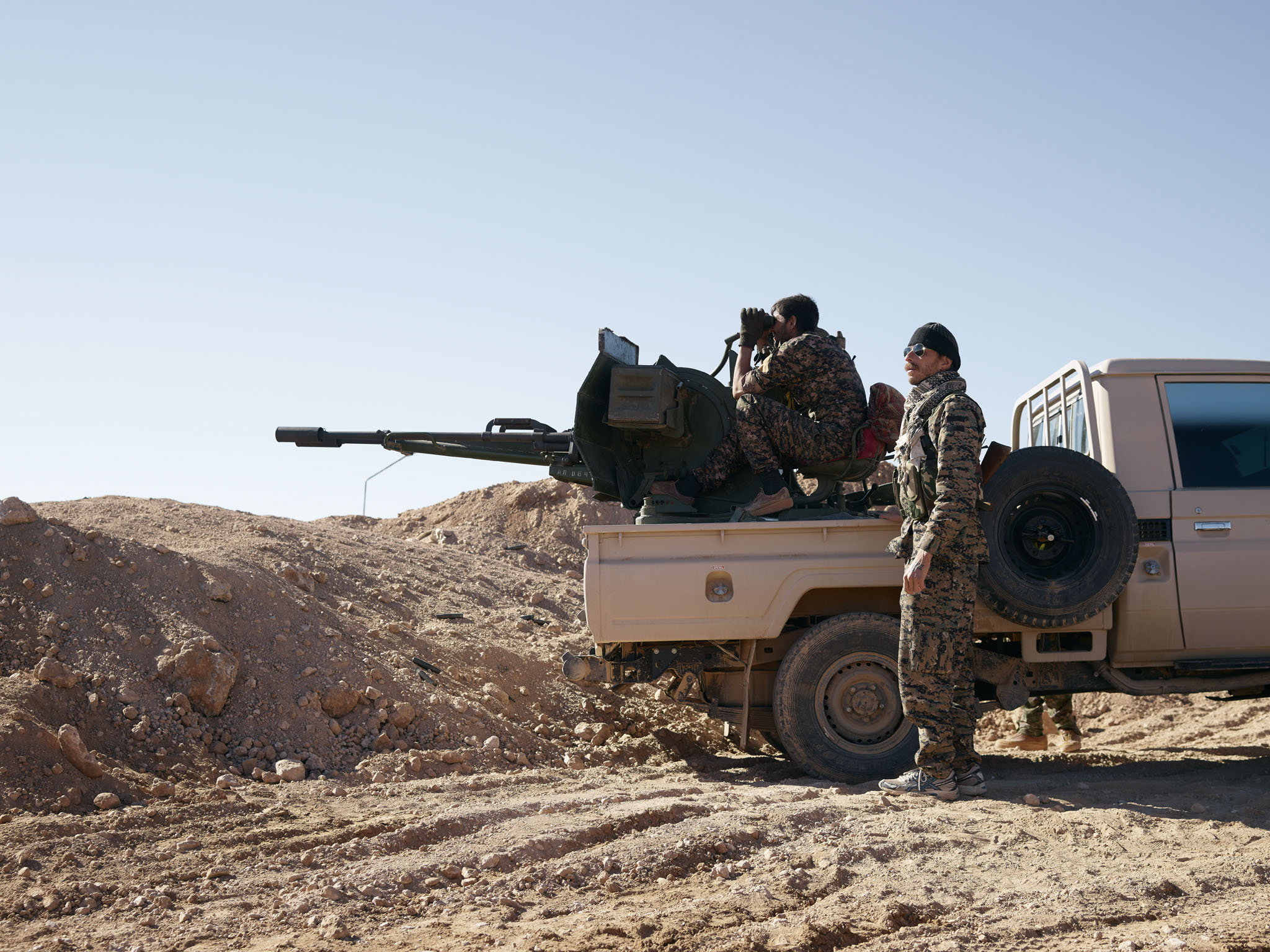
Tommy, Danish YPG volunteer.
One of the men standing beside the truck, watching through binoculars, turns to me and to my surprise, asks in perfect English, “Do you want some ear muffs? It’s kind of loud.” It turns out not to be an American SOF member, but a Danish guy named Tommy- an adventurous foreign volunteer in the YPG.
Just minutes after shooting, a blood-curling whistle from above is heard, and a split second later, the loud boom of a mortar striking no more than 20 meters away from us. Jan and I dive on the ground, anticipating shrapnel, and my camera gets full of sand. We crawl underneath the concrete barrier beside the truck.
“Shit me, that was a close one!” exclaimed Tommy, still standing stoically in place. He raises his binoculars to scan the city ahead.
Suddenly, another ISIS mortar lands 50 meters behind us, closer to the power plant. A minute later, another strikes the road we used to reach the power plant.
An instinct of fear compels me to want to get up and run away, but I am assured by Jan’s calm and experienced voice, “It’s better to stay here for now.”
The afternoon light is terrible for photos. I am lying down in the dirt like a dunce wondering if I would be able to summon more courage if it were sunrise or sunset. I doubt it.

Screen grabs captured from GoPro mounted on my camera.
Eventually, we gain the nerve to peek up from the concrete barrier and check what’s going on. The Kurdish man firing the weapon on the top of the truck yells to Jan in Kuridsh, “Comrade! If you hear another go chuuuuuu, lie down. Okay?”
A new mortar lands near their truck. “I think they are aiming for the truck,” I say.
“No. They are aiming for… all of us.” Jan says with a smile- a sick sense of humor I have grown to appreciate.
Jan continues, “Mister, you said you wanted to see action! So, I brought you to the action. This is the reeeeeeaal action! What’s wrong with you?” We laugh together nervously. I can tell he’s trying to make me feel better. It works.
The mortar strikes eventually slow to a stop and we decide to make an exit, running back closer to the relative cover of the nearby water plant. There’s a group of Arab men calmly sitting in a circle in the open, totally unbothered by the shelling, and discussing their next steps. One man has the jacket of a Syrian regime soldier, but its original badges have been torn off. He introduces himself as Abu Sayaf, a commander of Free Syrian Army (FSA) rebel group Raqqa Martyrs Brigade. His fighters are about to enter the city in a small group carrying AK-47s and rocket propelled grenades, running across the open field and entering the few cleared buildings at the city’s edge.
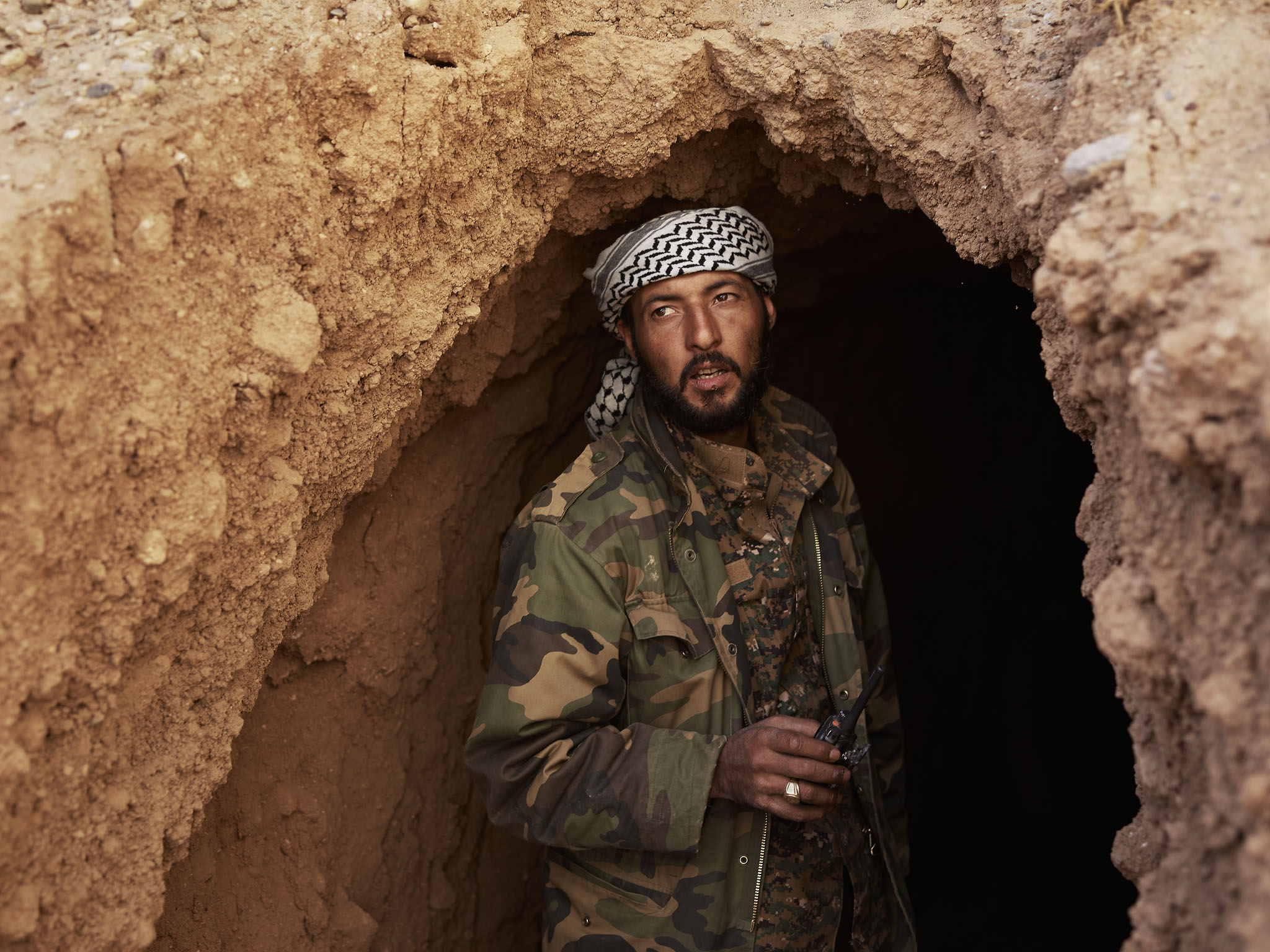
Abu Sayaf, Commander of Free Syrian Army rebel group Liwa Shuhada ar-Raqqa, explores an ISIS tunnel.
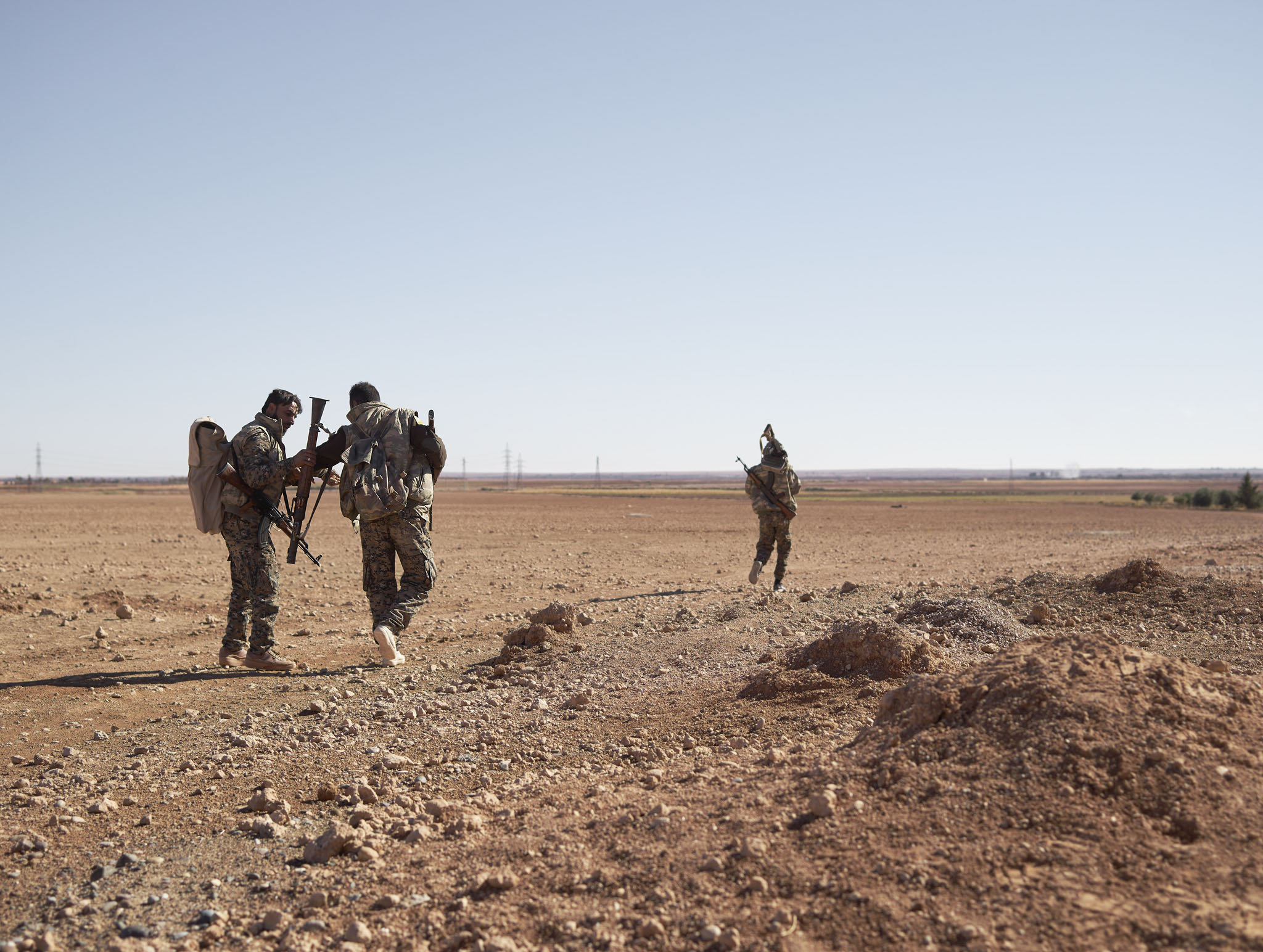
SDF Fighters enter ISIS-occupied Tal al-Samam on foot to fight.
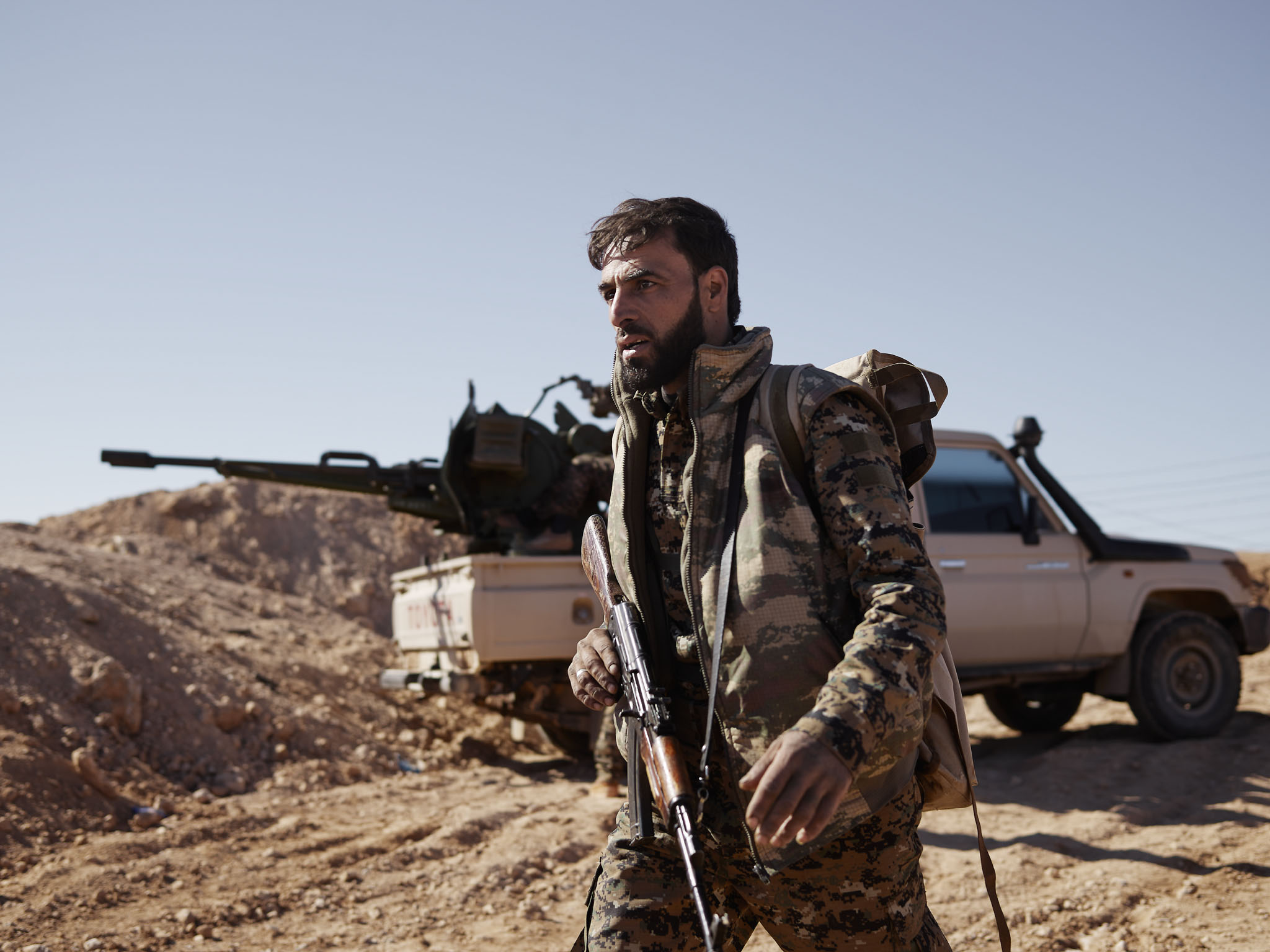
An SDF fighter from Raqqa walks to ISIS-occupied Tal al-Samam to fight.
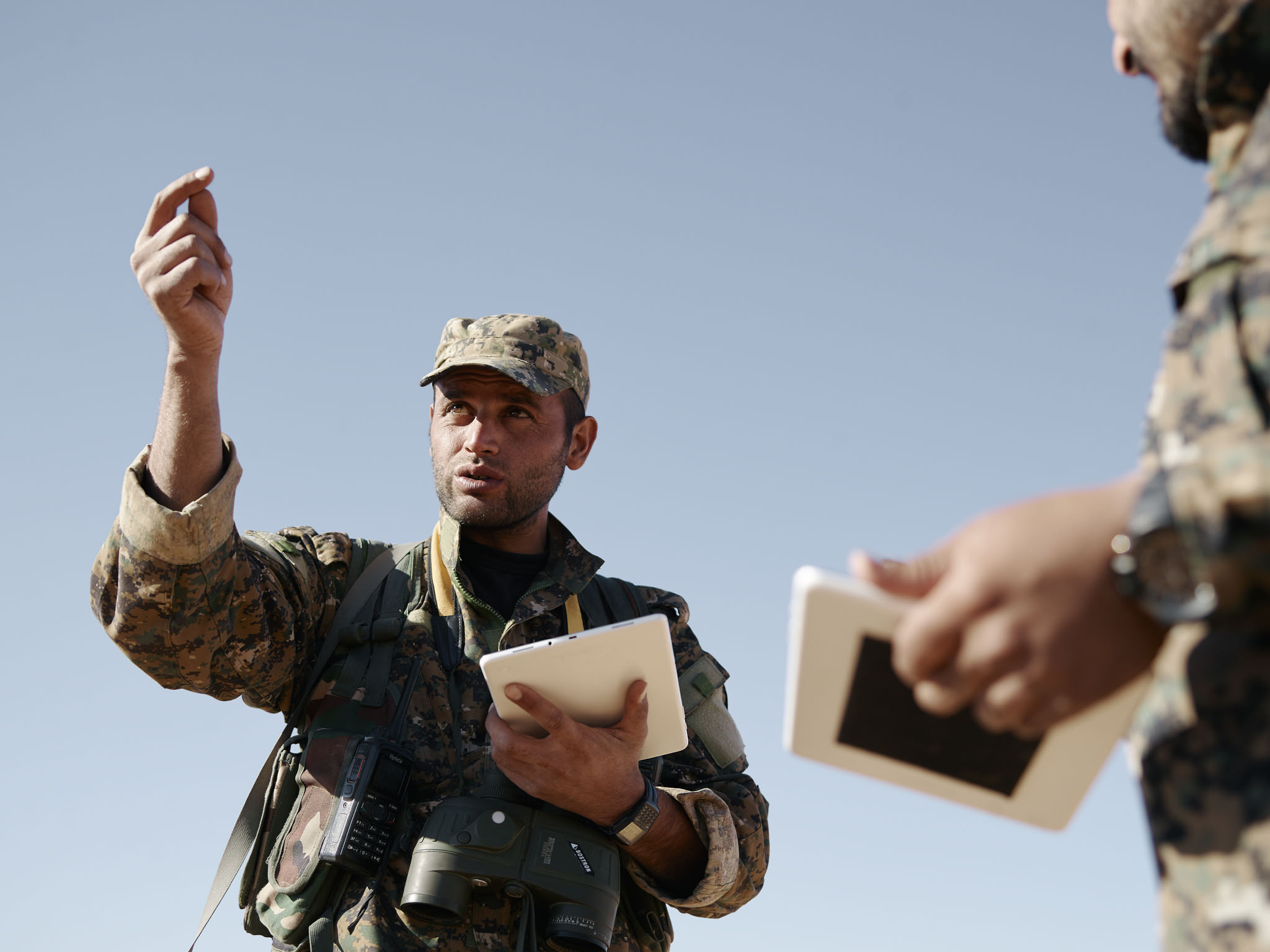
SDF Commanders co-ordinate coalition airstrikes and troop movements using digital tablets.
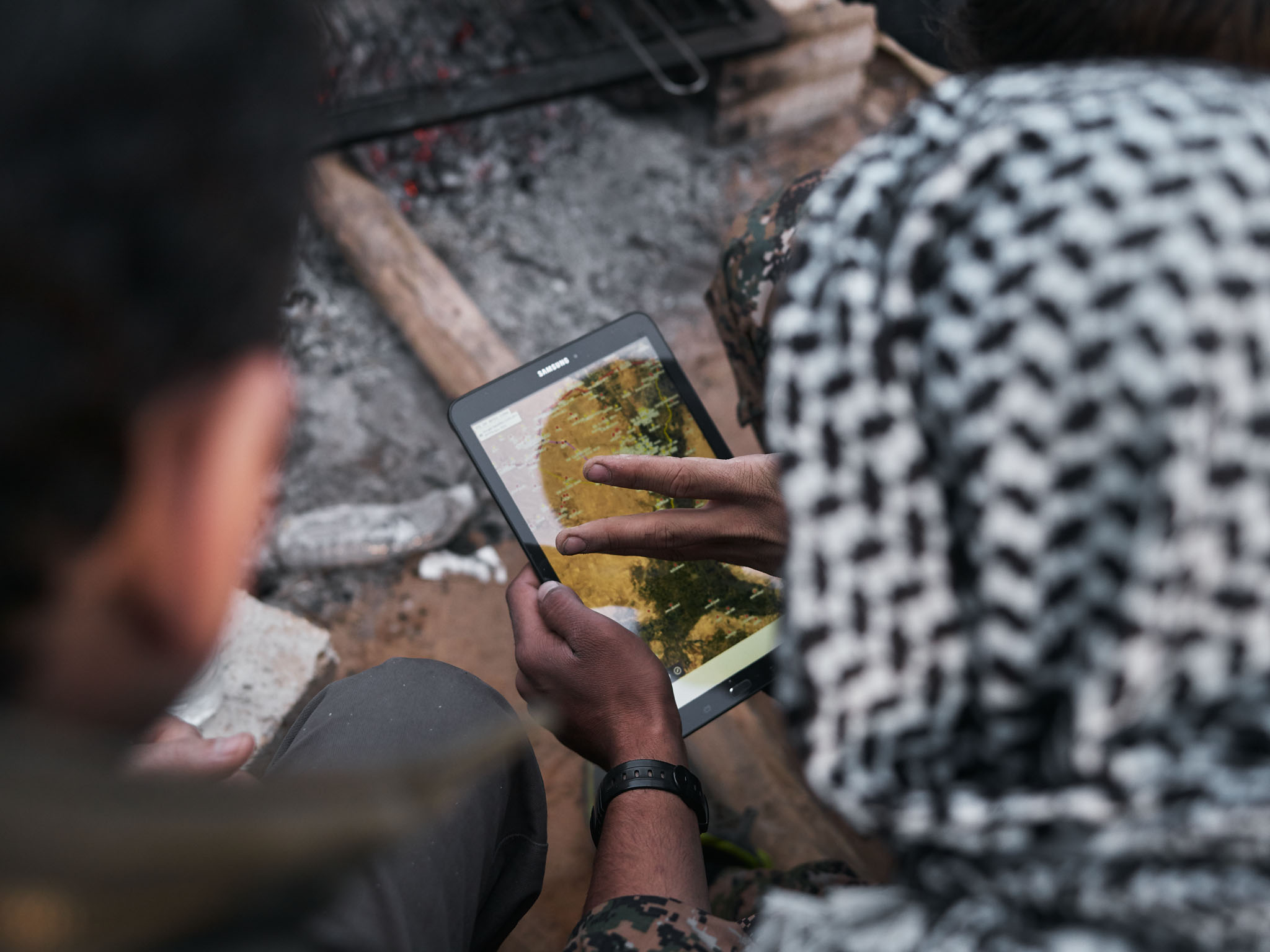
A digital tablet is used to co-ordinate troop movements and coalition air strikes.
Like many Arabs in the SDF coalition, Sayaf’s fighters are all locals from Raqqa. During a pause in the operation, he shared a few stories about the early days of the war, before ISIS took over. It is not the simple tale presented in Western media of revolutionaries fighting to kick out a brutal regime as a unified force, but rather one of various armed groups with sometimes radically different visions for Syria, only linked together by their will to fight the Assad regime.
“Those groups all gave bay’ah [pledging allegiance] to Daesh [ISIS],” Sayaf told me, explaining that once the regime was removed, factions from both FSA and Al Nusra, Al Qaeda’s franchise in Syria, joined ISIS in Raqqa city, provoking confusion and infighting.
Sayaf’s rebel group eventually rejected the extremists, and found themselves forced out, and thrown into a loose alliance with the Kurds of the YPG and YPJ. The coalition hasn’t always been smooth sailing, as political views differ. For now, however, they share a common desire to rid the area of the extremists. If the battle were to eventually move into Raqqa city, Sayaf explained to me he expects to find some of the former FSA members who fought the Syrian regime alongside him in the early days of the war, but now opposing him on the side of ISIS.

SDF fighters monitor a position facing a road partially under the control of ISIS.
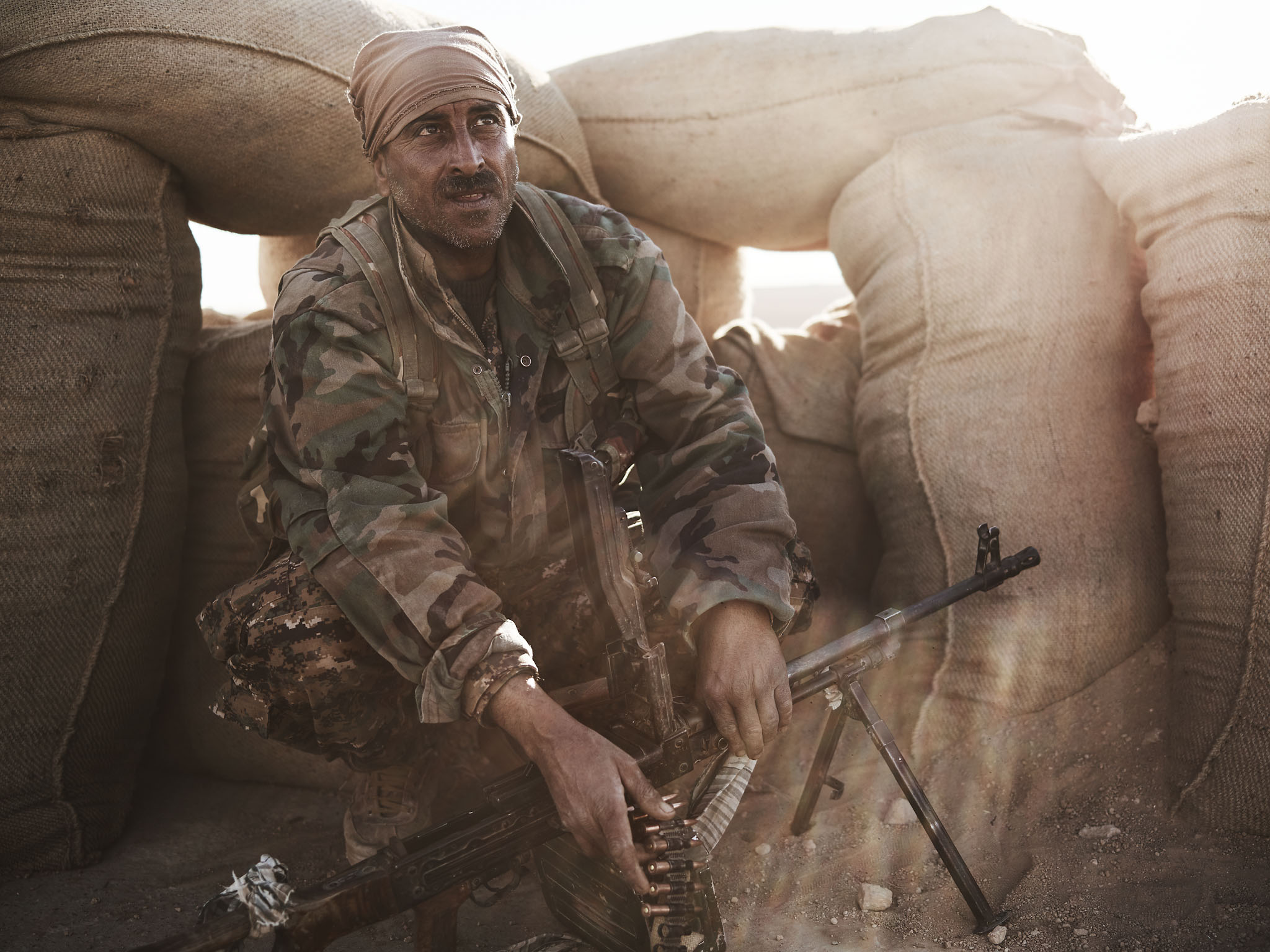
An SDF fighter loads a PKM machine gun in a firing position facing a contested road.
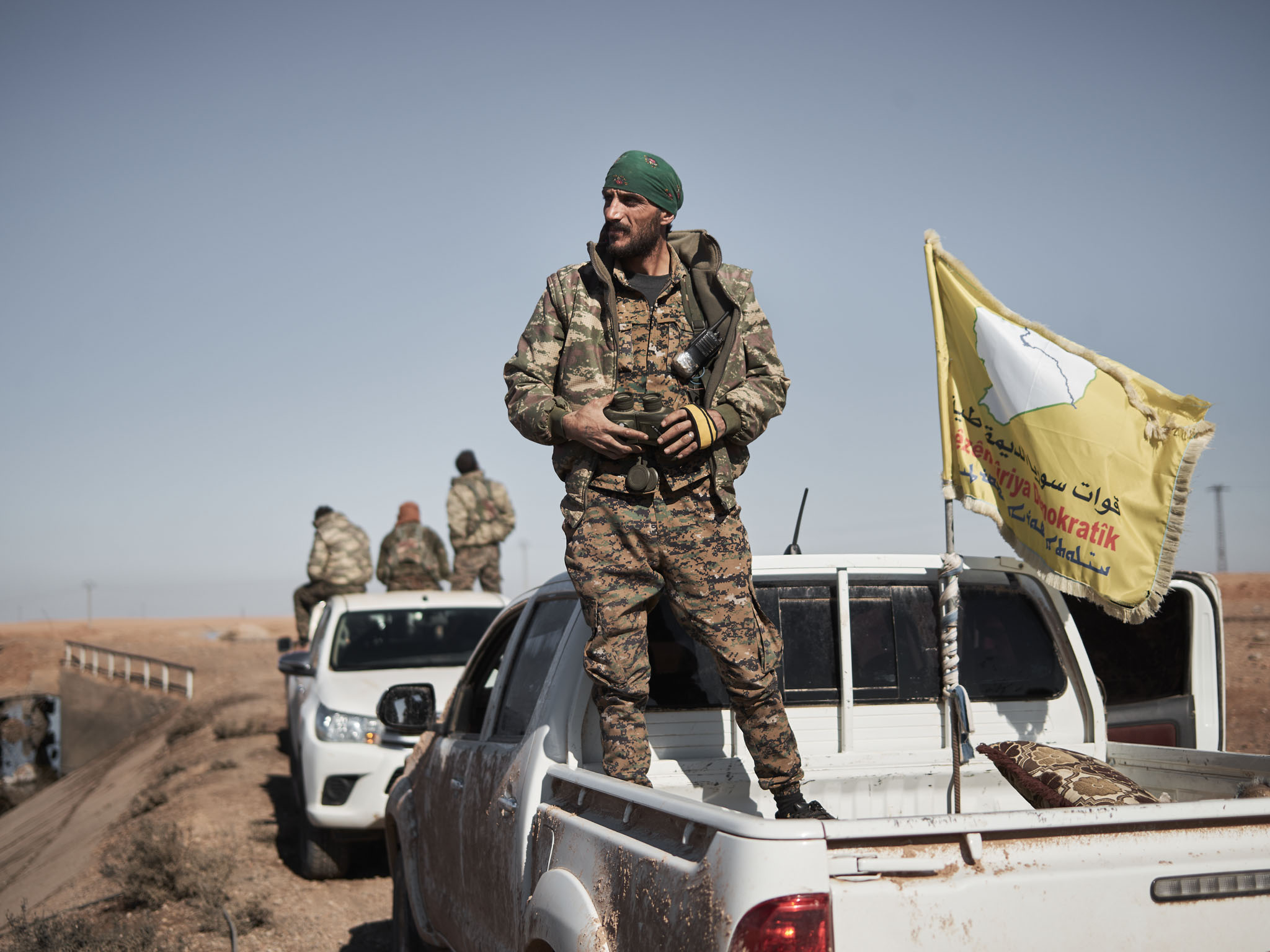
An SDF commander prepares his unit to enter Tal al-Samam.
As the light of day grew longer, it became apparent the SDF were not able to push further into the city center that day.
Days after leaving the region, I stumbled upon a shot of an ISIS flag coming down on Twitter, shared by the SDF’s official handle. Shouts in both Kurdish and Arabic rung out as the flag was thrown to the ground. It seemed the media team had gotten the shot after all, it had just taken a little more time than anticipated.
Last Night in Raqqa
Back at Murat’s camp on my last night in Raqqa, we sat once again around the fire, talking about the latest developments in the region. This time, the feeling was much different. News had come that Turkish airplanes had begun a new phase of both shelling and air strikes on SDF positions outside Manbij- a large city the SDF had cleared of ISIS previously with coalition air support. Turkey’s military and allied Islamist rebel groups now occupied the countryside to the west of the city, and minor hostilities had previously broken out. Now a new level of escalation was underway.
The SDF fighters seemed betrayed. From their perspective, America was tolerating their forces to be attacked by Turkey simultaneously while the Raqqa offensive was underway. The radio crackled late into the night with updates, as commanders were unsure of the extent of the bombing, and unsure how far the Turkish backed forces would try to press into Manbij itself.
“Turkey is acting as the air force of ISIS,” one said. “They want to slow down the Raqqa operation,” another theorized.
Just a week later, an American SDF volunteer - Michael Israel- would die alongside 11 others in another round of airstrikes on a base in Arima, a base outside Manbij.
A strike on a passionate foreign volunteer among locals at a base is one thing, but targeting the American SOF is an escalation Turkey will likely never attempt. Other than a shared objective of getting rid of ISIS, it’s easy to imagine that the SDF kept the American SOF members with them in Raqqa as their own shield against Turkish air strikes.
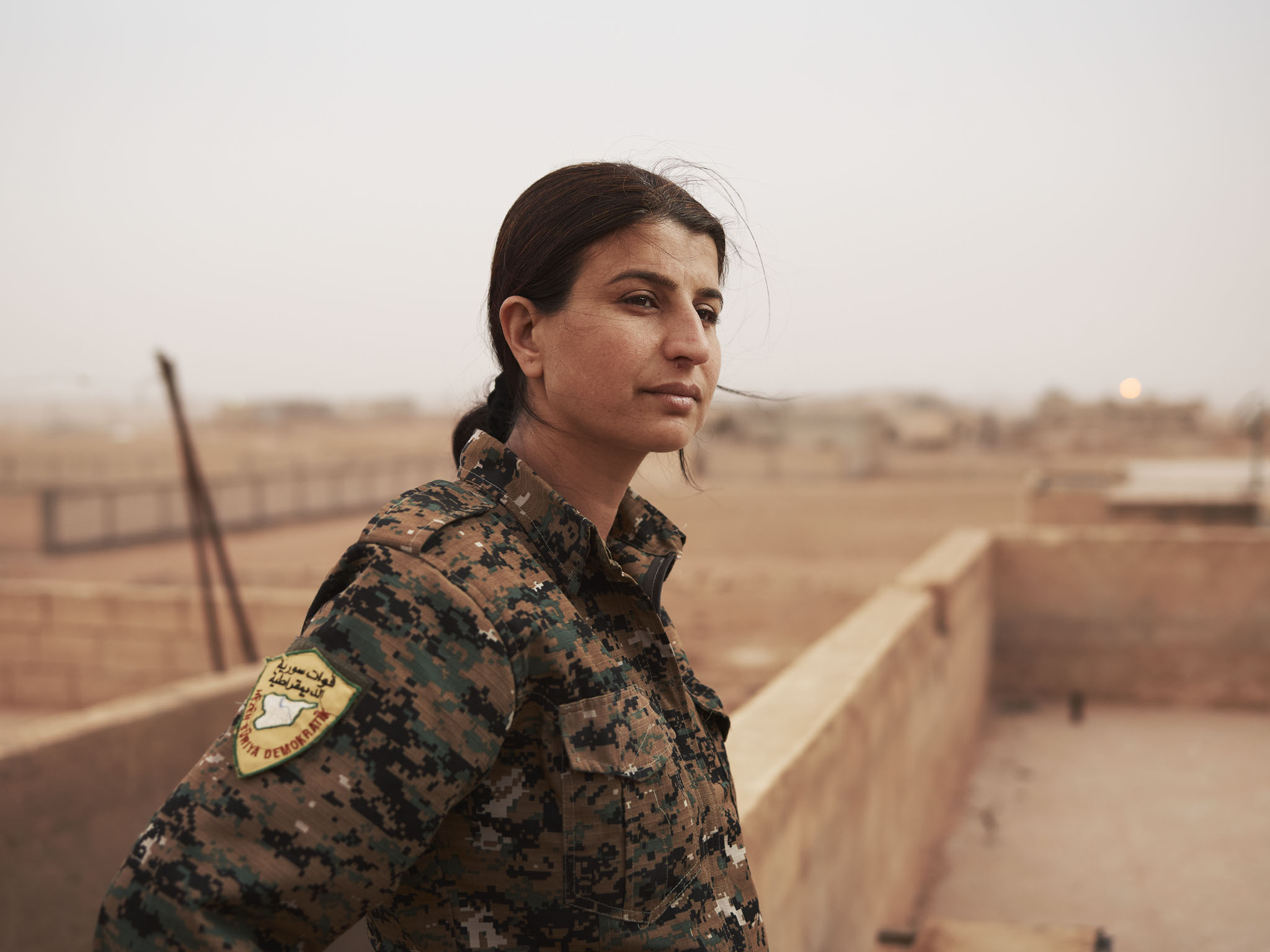
Cihan Shekh Ahmed, Spokeswoman of SDF "Wrath of the Euphrates" operation.
The Future
It’s impossible to define the conflict in Syria as a ‘civil war’. Rather, it is a struggle that has been prolonged and escalated due to the puppeteering of superpowers. The proxy war is waged remotely, at the expense of Syrian blood.
Both ISIS and the SDF are organizations which sprung from the torrents of this ever-evolving brutal showdown. Protestors that took to the streets in 2011, demanding democratic reforms from the Syrian regime could not have anticipated either of these rising to such a position of influential power.
The flames of ISIS which Erdoğan once helped spread have come back to burn his hand. Its military and allied FSA proxy forces are now directly involved in Syria and struggled for months to make progress against ISIS in Al Bab, a much smaller city than Raqqa. The quick offensive on Raqqa the Trump administration craves may prompt a larger investment into the SDF rather than its NATO ally. The Turkish government finds itself in a difficult position, unable to unwind itself from such a political conundrum. It is still unclear what the next steps will be.
The outcome of battle for Raqqa will be a defining moment and a crossroads in the war. It may be the point in which the superpowers let go, or abandon their key partners after short-term goals are realized. However, Syria’s long-term future will not only be decided by far away politicians, analysts, journalists, or photographers. Her future will also be decided by those who still have the will to fight.
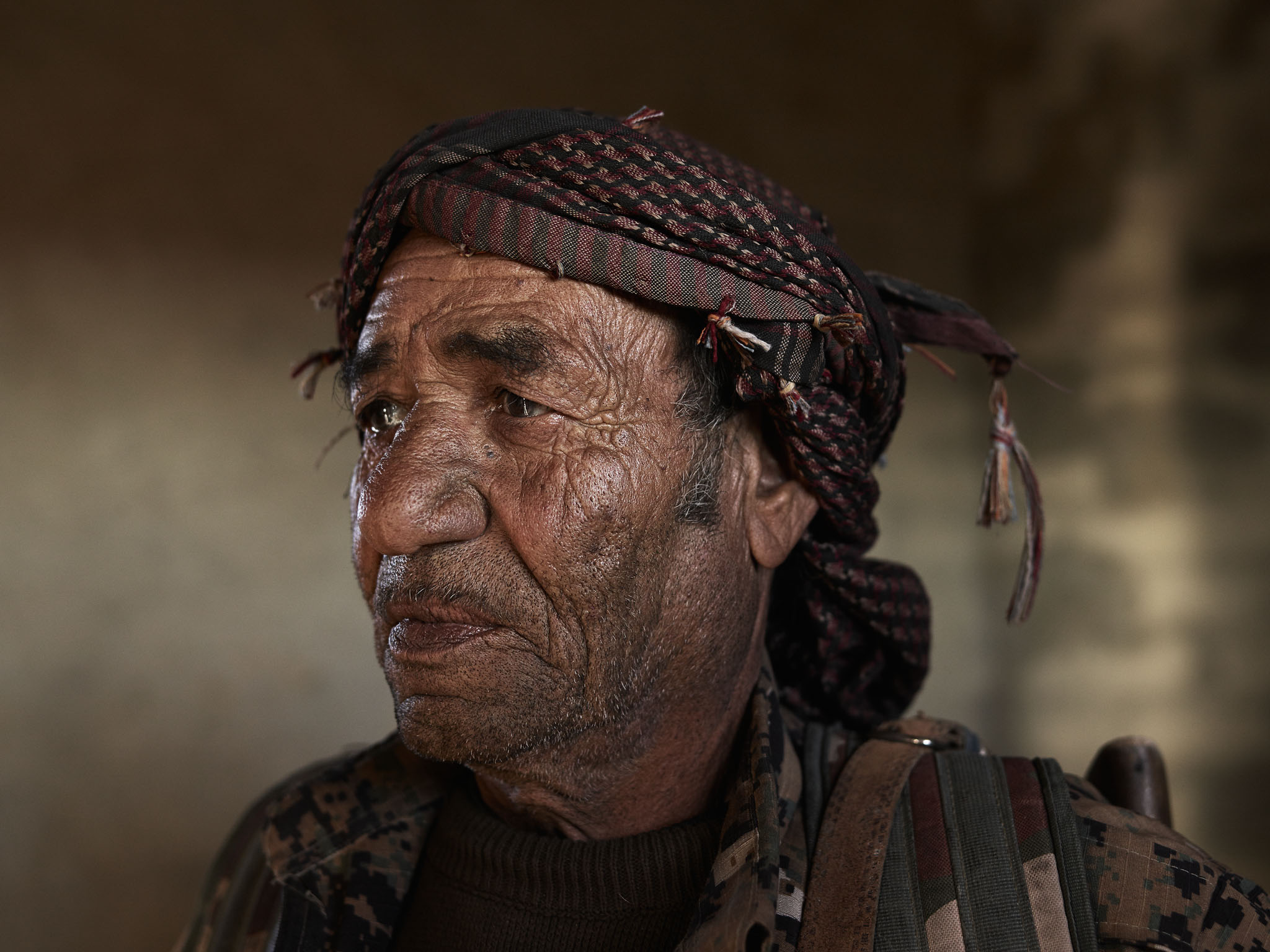
Portrait of Mohammed al-Ali, a 65 year old SDF volunteer from the countryside of Raqqa.
If you’ve made it this far- thanks for reading. Although a couple of these photographs ran in Rolling Stone magazine in a recent article, and this blog post will be featured on SOFREP, my ongoing work from Iraq and Syria is very much a passion project.
We are currently putting the final tweaks on my new film shot in this region, and coming up with a creative way to share it online. If you’d like to be the first to hear about it, please subscribe using the button at the top right of this page. I’d also love to hear your comments on this blog.
JL
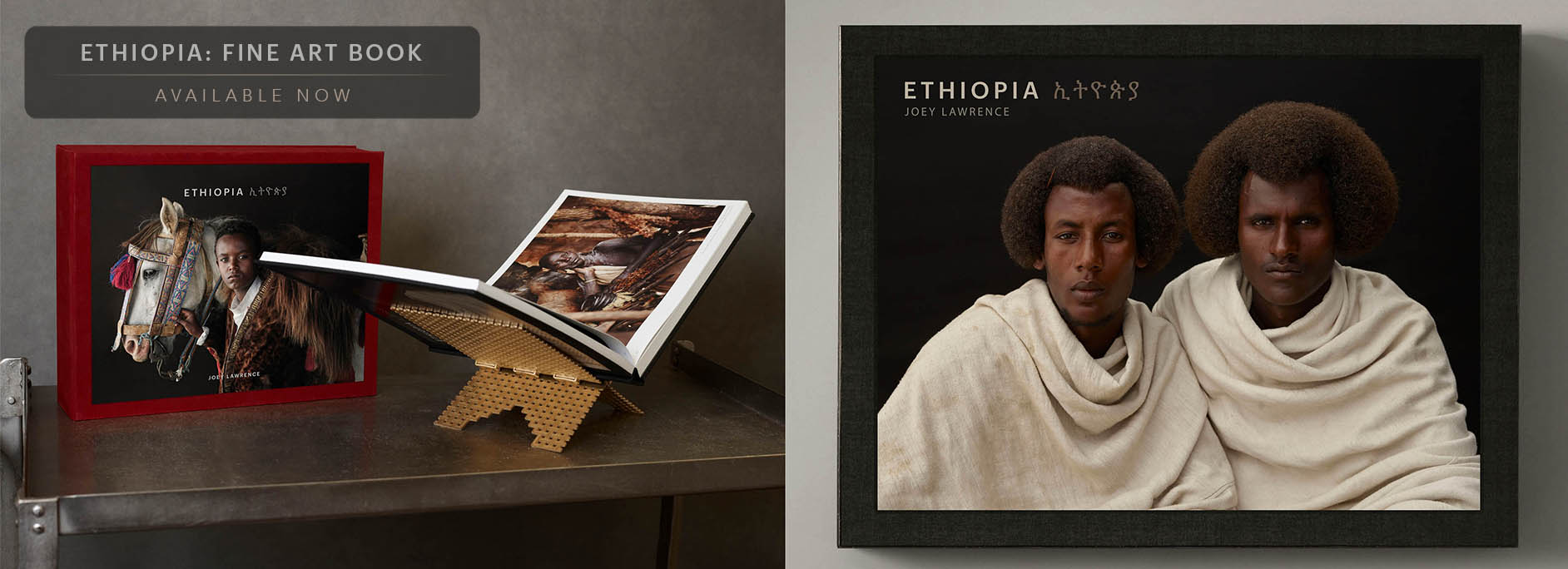

ADD A COMMENT (57)
Pete Foti // March 03, 2017 10:54
Thanks for sharing a great story of Kurdish freedom. Be safe.
Mark Campbell // March 03, 2017 12:35
Great to see you are there Joey. Stay safe. I'd like to use your images on Twitter if you don't mind?
Daniel McQuillan // March 03, 2017 12:56
Amazing as always.
Joey // March 03, 2017 13:09
Of course that's fine, Mark. Thanks
Pamela Hall // March 03, 2017 13:19
Thank you for sharing.
Nelson Hill // March 03, 2017 13:20
I can't really express the gratitude I feel when I see your documenting and the representation of these people through your photographs.
I hope you someday have the skill to make it count like you do...
Be safe, and I will look forward to meeting you someday.
Thank you.
Whitney // March 03, 2017 13:29
Amazing. Thank you for sharing - look forward to watching the film.
Rich A. // March 03, 2017 13:36
Fantastic! Can wait to see more.
Johann Wegmann // March 03, 2017 14:07
God bless you Joey
enry // March 03, 2017 14:22
Thanks for showing us the fight against intolerance and murder. Go ahead comrade
Gareth Woods // March 03, 2017 15:02
Great reportage. Thanks for giving us the chance to see it.
Karen Castro // March 03, 2017 16:15
Thanks for this, the photos and journal offer insight into a conflict difficult to understand. I especially appreciate your ability to see the big picture and reference both sides believe they are liberating the land and the bullets pierce the ideals held on both sides, well said. Great job.
James Teague // March 03, 2017 18:17
I've been following these fighters since beginning of Kobani. I'd only add to that section that some Peshmerga brought in some heavier weapons that also helped turn the tide. SDF, YPG, YPJ have amazing endurance, discipline and focus. I don't lean to communist doctrine, but this group has many of the right ideas. Thanks for your story.
Amar B Patel // March 03, 2017 21:31
Magnificent details and work all the way. your work always inspire us!
Randy Routt // March 03, 2017 23:16
powerful, guided,
Brandon Wells // March 03, 2017 23:51
I know its not nearly as important as the story of this whole project, but it would be cool to see a little more in-depth explanation on how you actually photograph these types of projects. Maybe not specifically equipment, but your planning, strategizing, and your practical approach to capturing photos in these situations. Keep up the great work dude!
Renat Kuenzi // March 04, 2017 02:14
Journalism at it's best! Keep on your fantastic work in the name of humanity!
dutchnational // March 04, 2017 03:05
Very nice report, giving a human face to the struggles around and towards Raqqah.
I would be interested in in hearing a bit more about about how far YPG forces are involved in the struggle as there is some confusion about this in the media.
I there any talk about "after the fighting?"
Mike // March 04, 2017 07:42
I have been following your work for a while now and find your work getting better and more worth while I dont feel I am being fed what politicians want us to see, thank you for the risk you are taking and I will surely keep watching for the next Joey adventure
Robert Leathers // March 04, 2017 08:02
Journalism as it is supposed to be done. It is about the people and you convey that fact so very well. I see it in the faces of the fighters, the children and those who are affected by the fighting. Continue to stay non-political and just present from the eyes of those on the ground, remarkable work and I will share it with everyone I can that has a desire to see the truth. Stay safe.
Jan Veenstra // March 04, 2017 08:49
Thanks so much for making and sharing this powerful documentary.
Cynthia Roderick // March 04, 2017 08:55
I admire your courage in working on this series...I wonder why so many of the images show the fighters still being self-conscious in from of your camera? Did you have too much equipment with you to blend into the background? I know it isn't easy... and there's some wonderful work here... and again, thank you for going there ....
Ronan // March 04, 2017 08:57
Great story, far from the one served in the media. Thanks for what you shared Joey!
Ronan // March 04, 2017 08:57
Great story, far from the one served in the media. Thanks for what you shared Joey!
Claudia // March 04, 2017 09:19
What a great articule, pics are amazing aa always, I Washington Lost un muy lindo and un some point I for git it was something real, greeting s from México,
abhinav // March 04, 2017 10:07
wow! this history seems so convoluted! Assad and others are fighting against ISIS, Obama and his sycophants are fighting against Assad, there by helping ISIS. The liberal messiah, the artist world's sole guiding light is, in fact, trying to create a hooligan rule in the name of Arab spring, and all these champagne tasting artists, film makers, photographers, designers et al are showing as if Obama is the best thing that has happened to mankind. In the midst of this mockery, at least, we have some artists like Joel L. who go and photograph the real story. They do not sit and share crap on Facebook to show how cool that crap Obama is. The whole of west Asia is in turmoil, 50% due to that liar Bush, and the other 50% due to that Obama the barbarian. Thanks for siding with the good. Thanks for not being another crooked artist! May your tribe increase!
Daniel Kik // March 04, 2017 10:27
Thanks for sharing this great insight, what a thing to experience.
MP SINGH // March 04, 2017 10:40
Amazing work Joey. You have captured the very essence of this conflict, thanks for sharing the work with us. And its great to see how actively women are engaged in fighting shoulder to shoulder with men. Every image stands witness to the point that it's a passion project.
bravo !
Oscar // March 04, 2017 14:00
Please be safe.
I love your work and the passion you put into it.
Also great shots, wish I had a medium format with me as well.
Godspeed!
Jason Dashney // March 04, 2017 15:43
If I pulled a stunt like this, I'd be just as fearful of my mom as I would enemy attack. Hopefully she forgives you ;-P. That's one helluva field test for a medium format camera, you nutcase.
Brett WALSH // March 04, 2017 16:23
Hi Joey,
I've followed / admired your work for many years now, from your (very) early, tutorials.
It's great to see that you continue to develop so impressively. I find your work ethic as inspirational as the quality of your portfolio.
Truly 1st class Reportage photography here.
Don't hesitate to let me know if you're ever in Paris. Would love to meet up/show you around.
Keep on doing what you're doing :)
Fredrik Lonnqvist // March 04, 2017 18:21
Thanks for being a brave human being!
Julie Dietrich // March 04, 2017 21:04
Thank you for taking the risks to provide brilliant journalism.
Alex Musgrave // March 05, 2017 03:03
Amazing work Joey!, looking forward to watching the film!.
Do you plan on going back and doing more personal projects?
Annemarie Bruggink // March 05, 2017 09:04
A very human story that makes you feel close to the real people of this real war. No media report gives that feeling. I have great respect for people like you. Hope you will keep safe and bring us many more such stories
Brendon Fidek // March 05, 2017 09:44
These photos are incredible, such a good read too. Were these taken with the 80mm lens?
Denis Vahey // March 05, 2017 10:07
Joey,
I hope this finds you well.
Your work is stunning and you go from strength to strength as a photographer. I'm with Brett Walsh above when he mentions your moral compass/ethics being as inspiring as your portfolio. This series and story is top class. You've given a voice to the voiceless in many ways. Keep up the great work. And like Brett I'd also like to extend the hand of welcome if you're ever in Ireland.
Peace & love,
Denis
Dan Rodgers // March 05, 2017 12:59
Your descriptions are as powerful as your photographs. You have my respect...
misael mendez // March 05, 2017 15:26
thanks for sharing!!!
ben spencer // March 06, 2017 01:32
Hi Joey, I want to add my gratitude for these images and explanations. They are extraordinary; I feel I am getting a glimpse of reality, especially the human reality behind the war. Thank you! Ben
Hamish // March 06, 2017 06:32
Hey Joey! You posted me one of your original CD's with your fist tutorials on many years back and I've followed your career since, well done mate, fabulous work! I'm shooting at a women's prison in Kenya next month, your photography always inspires me in my own work :)
Hamish.
Ida Larsson // March 06, 2017 11:03
Fantastic work!! If someone mayed it, it got to you - of course!! Great job.
Helder // March 06, 2017 19:05
Hi Joel, thanks for sharing your experience is always good to see your new work.
Ray Sands // March 07, 2017 07:09
As we say here in Ireland, - KeeperLit! Looking forward to the film.........
Bram Berkien // March 09, 2017 06:07
TL;DR
Just kidding, I really appreciate the depth and political analysis in your writing here Joey. Can't wait for your film to come out. Any way we could see more shots till then?
Katie Arcara // March 09, 2017 06:58
Thanks for opening my eyes to a larger picture of today's world with your storytelling - through film and the written word. The first piece you did compelled me to personally research the Kurdish people's history, as well as unearth a newfound sense of personal obligation to better understand the Syrian conflict to the best of my ability. Two subjects about which I still feel incredibly naive, but challenged to listen and seek for the sake of human understanding. I am alive today, I have a voting privilege in my country, so I have a responsibility to do my best to be informed, to pursue empathy and compassion from all angles. As I continue to try to stretch and learn and grow, I'm so grateful for the way you use art to tell these stories as a stepping stone for people like me to access in the process. I'm no photographer, but I'm always learning about using design to communicate and challenge and make change so from that level at least I can greatly appreciate your hard work. And from an integrity and human compassion (literally, co-suffering) standpoint, I'm grateful and inspired to see someone who is clearly so accomplished in their craft approaching each project and relationship with obvious dignity, respect, humility, and genuine love toward the people you encounter and give voice to. From nobody special, just, thank you!
Stevie // March 12, 2017 08:30
UNBELIVABLE photos and thank God you did not tell your Mother before you went!! I would have freaked out if my sons had undertaken this project. Well done Joey, the colour, composition and story is truly amazing, Thanks for bringing this important story back to us all. Long live and God save the brave Kurdish YPG fighters and all freedom fighters.
Charles Clark // March 14, 2017 05:53
Spectacular journalism. Most of the Worlds phony journalist could not touch the quality of this work. America's leaders should read and watch. They sometimes seem clueless on what is really going on in Syria. Daily we see news media pontificating that the US is getting ready to go after Raqqa with no mention that the YPG/SDF is already at the gates of the city. Is this ignorance or just fake journalism? Either way it;'s terrible journalism. My biggest fear is that the US will abandon the YPY/SDF once their goals are achieved. US history is full of such betrayals.
Harry Jackson // March 16, 2017 05:35
Very interesting and expressing feelings of the captured soldiers. even without reading the photos explained the content of the article. Good work though
`nick Middleton // March 24, 2017 13:47
Thank you for sharing this. I'm looking forward to the film. Great work Joey
Laura Mansur // March 30, 2017 08:08
Dear Joey L.,
Thank you for creating these images and telling the story of what is going on in Raqaa. Your images are breathtaking. You've captured the emotions and the drama of that far away place. Laura
Laura Gomez // April 19, 2017 19:48
These are amazing. Thank you for this. I would love it if you can take a look at www.romanlewckephotography.com and give some feedback. It would be great, thank you :)
Bajro Nuhanovic // September 06, 2017 22:23
Thank you to the author for bringing the Kurdish story to light in a precise and concise way. The struggle for democratic self-determination in northern Syria deserves all the help it can get. The photographs are stunning and I have to admit, perhaps because of my own bias, that I find the pictures shot in Syria the most impressive of the pictures you've shared on this blog.
Best of wishes for your future work. I hope to see more from Syria.
Mark Fuller // September 08, 2017 10:34
Thank you for your wonderful coverage of this historically important development. The Kurdish Revolution needs your kind of coverage. If you don't mind, I've posted some images of your photos on FB. Do you have a link for your documentary "Born from Urgency"?
Thank you, and be safe.
Harry // September 15, 2017 13:47
Respect, be safe. I just love those woman fighters the most inspiring people.
Tina Devis // November 04, 2017 06:07
Thanks for your honest effort, Have a nice journey.
reza sadeghi // December 02, 2017 07:13
So painful , and thank you for sharing yr journey.
Your comment has been posted